Privacy settings
Here you will find an overview of the types of cookies used on the website. You can set your consent for each category individually. Further information can be found in the privacy policy .
- Essential Cookies For the use of the website with all functions (e.g. user settings, watch lists, etc.)
- Statistics Statistics Cookies collect information anonymously. This information helps us to understand how our visitors use our website.
- Marketing In order to provide you with the best possible offer in cooperation with our partners, we use marketing tools. For example, in order to use our chatbot, you must activate this setting.
- External contents Required for viewing external media and third-party content. The provider may set cookies for its part. The respective data protection regulations of the provider apply.
- Inspiring Germany
Cities & Culture
- Nature & Outdoor Activities
- Royal Palaces & Castles
- Experience & Enjoy
- Current highlights
- Sustainable travel
- Barrier-free travel
- Easy language
- Federal states

Trier: a charming city with so much Roman heritage
Founded in 16 BC during the reign of Roman Emperor Augustus, Trier is Germany's oldest city and an important site for ancient art treasures and monuments, such as the Porta Nigra, the best-preserved city gate from the ancient world.
Roman emperors and later bishops, electors and ordinary people have made Trier what it is today. A whole host of world-class architectural monuments – many of which have UNESCO World Heritage status – and art treasures have been preserved and tell moving tales of times gone by. Porta Nigra, the Amphitheatre and the famous Imperial Baths, where the Romans went to relax, all bear witness to Trier's extensive classical heritage. Medieval buildings, such as St. Peter's Cathedral – the oldest church in Germany – and the early-Gothic Church of Our Lady are also deeply impressive.
Porta Nigra
Hauptmarkt square, st. peter's cathedral and church of our lady.
Trier is second to none when it comes to dining. Excellent wines from the Moselle, Saar and Ruwer wine-growing regions do of course play a key role here, while shops, cafés and bistros across the city entice visitors to stroll around or watch the world go by. A diverse mix of music, performing arts and entertainment is on offer in the city's cultural institutions and trendy clubs. In June, the Old City Festival is a sight to be seen on the Hauptmarkt square, which would ordinarily be lined with stalls selling flowers, fruit and vegetables six days a week. In late November, the aroma of gingerbread and mulled wine wafts through the narrow alleyways, which are adorned with festive lights and lined with rustic wooden stalls. There's no doubt that even Emperor Augustus would have loved it.
Discover more
Design museums: a celebration of beauty, art treasures throughout the centuries, must-see museums, top tips for special holiday experiences, cities with industrial history: travel back in time to the 19th century, classical art museums: genuine masterpieces, explore the surroundings.

14 Top-Rated Attractions & Things to Do in Trier
Written by Bryan Dearsley Updated Dec 23, 2023 We may earn a commission from affiliate links ( )
Trier, Germany's oldest city, can trace its roots back some 16,000 years. Tucked in a basin in the beautiful Mosel Valley , it has for centuries been an important place of trade and commerce. Standing testament to this fact are the many impressive Roman remains found here, most notably the spectacular Porta Nigra , a fortified gate in the Roman town walls dating from the 2nd century.
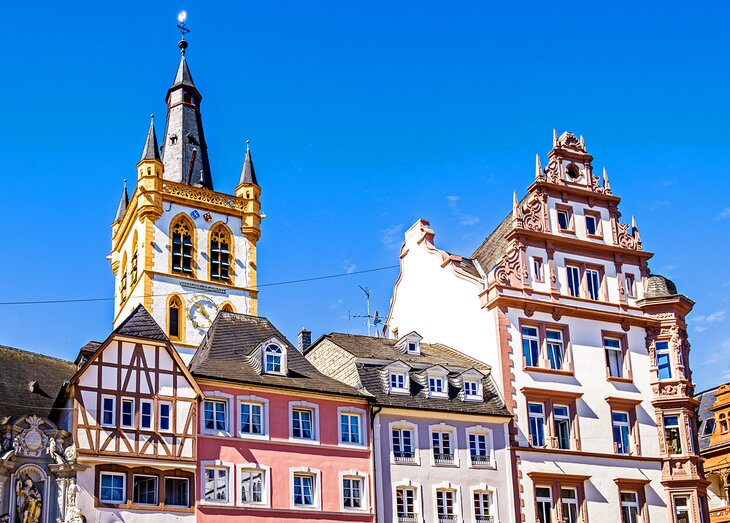
The municipality has designated much of its historic Old Town as the "Center of Antiquity," while the entire catalog of rare Roman monuments in Trier, along with the cathedral (Trierer Dom) and the Church of Our Lady, has been protected by UNESCO World Heritage status since 1986.
One of Germany's westernmost cities, Trier is located close to the border with neighboring Luxembourg and is also a great location from which to explore the rest of the Mosel area. One of the top things to do for tourists visiting this remarkable historic city is to join one of the many excursion vessels offering tours along the river as far as the Saarland region.
You can learn more about these and other places to visit with our list of the top attractions and things to do in Trier, Germany.
See also: Where to Stay in Trier
1. See Trier's Old Roman Gate: Porta Nigra
2. tour the historic cathedral of trier, 3. liebfrauenkirche: the church of our lady, 4. enjoy a concert in the roman-era aula palatina, 5. take a break in trier market square (hauptmarkt), 6. explore the electoral palace & the palace garden, 7. visit karl marx house, 8. learn about trier's history at the rhineland federal state museum, 9. trier imperial baths, 10. take a stroll across the old roman bridge (römerbrücke), 11. city museum simeonstift trier, 12. st. matthias' abbey, 13. visit trier's roman-influenced neighbors: konz, igel, and nennig, 14. take a drive to fell exhibition slate mine, where to stay in trier for sightseeing.
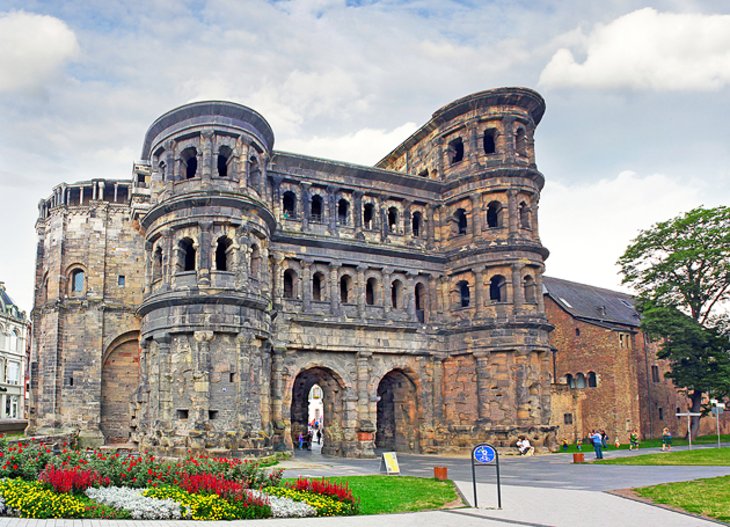
Dominating the north entrance to the Old Town quarter of Trier stands the massive Porta Nigra . Translated from the original Latin as "Black Gate," this impressive structure was added to the old Roman town walls as a fortified gate.
Now a UNESCO World Heritage Site and the largest such structure in Northern Europe, it's most commonly referred to by locals simply as "Porta." Built at the end of the 2nd century, it was later turned into a church, only to be converted back to its Roman appearance by Napoleon.
Today, its centuries-old, age-blackened stones are a must-see and are rightly considered one of the most beautiful sights to photograph in Germany. If possible, plan to see the structure as part of an informative one-hour guided tour, usually led by a costumed centurion. Tours sell out quickly, so try to book in advance online.
Address: Porta-Nigra-Platz, 54290, Trier
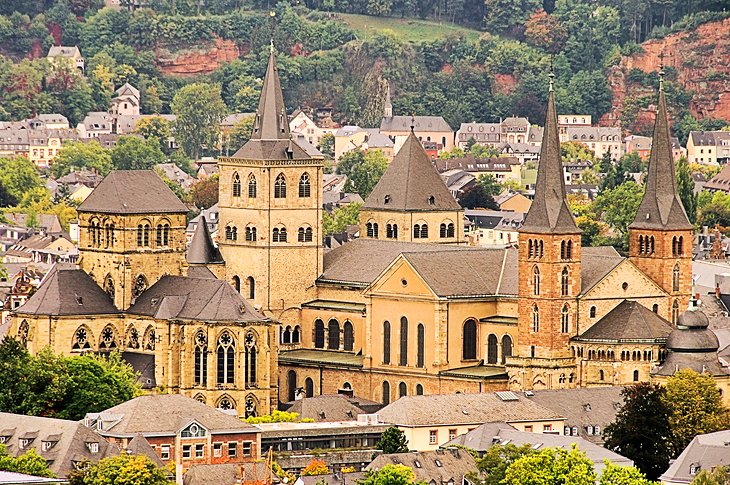
The huge High Cathedral of Saint Peter, more commonly referred to simply as the Cathedral of Trier (Trierer Dom), can trace its foundations all the way back to the 4th century, making it one of the oldest churches in Germany. Much of what is seen today was constructed in the 11th and 12th centuries and fully restored in 1974.
Highlights of a visit to this impressive cathedral include its magnificent monuments from the 16th to the 18th centuries. Other must-sees here include a robe reputedly worn by Jesus (the "Holy Tunic"), and the skull of Emperor Constantine's mother, St. Helena. A variety of fascinating tour options are available, including one that takes you into the bowels of the cathedral to catch a glimpse of an even older church structure. Time your visit right, and you might also be rewarded with a chance to hear the cathedral's organ in action.
Make sure you include the Trier Cathedral Treasury (Schatzkammer) in your itinerary. It's located on the south side of the cathedral's choir. Highlights include the 10th-century portable St. Andrew's Altar, or Egbert Shrine, one of the great masterpieces of Ottonian art. Also kept here is the "Holy Nail," said to have been one of those used during Christ's crucifixion, and the 3rd-century amethyst cup of St. Helena.
A related attraction, Trier Cathedral Museum (Museum am Dom Trier), is worth checking out for its large collection of religious artifacts and art. Also of interest is the nearby Church of Our Lady (Liebfrauenkirche) dating from the early 13th century, along with St. Paulinus' Church , built in 1754 with notable ceiling paintings by Thomas.
Address: Liebfrauenstrasse 12, 54290 Trier
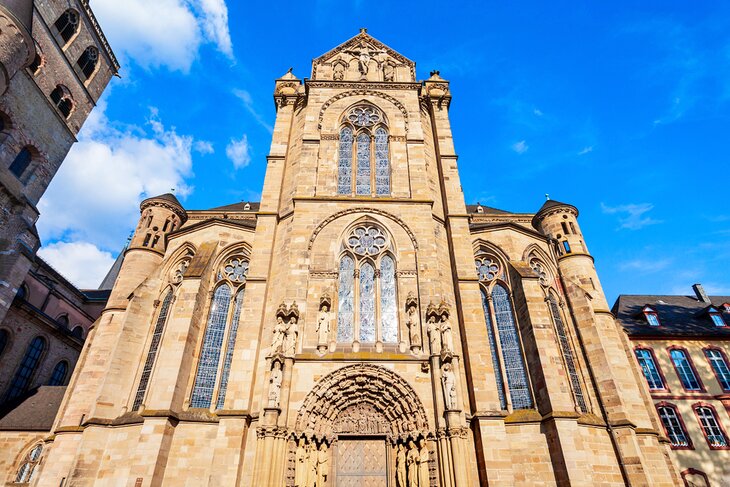
Located just steps away from Trier Cathedral stands the attractive old Liebfrauenkirche, or Church of Our Lady. Built on the foundations of a Roman church dating from the 3rd century, the present church was constructed around 1200 by French craftsmen brought in specifically for the task.
The result, widely regarded as the world's oldest church built in the French High Gothic style , is well worth taking the time to explore. Notable highlights include its round church-style floor plan, which includes four distinct portals and corresponding rounded niches, as well as eight rounded altar niches. If you were able to view from above, the effect would be not unlike looking at a rose, a reference to the Virgin Mary.
Address: Liebfrauenstraße 2, 54290 Trier
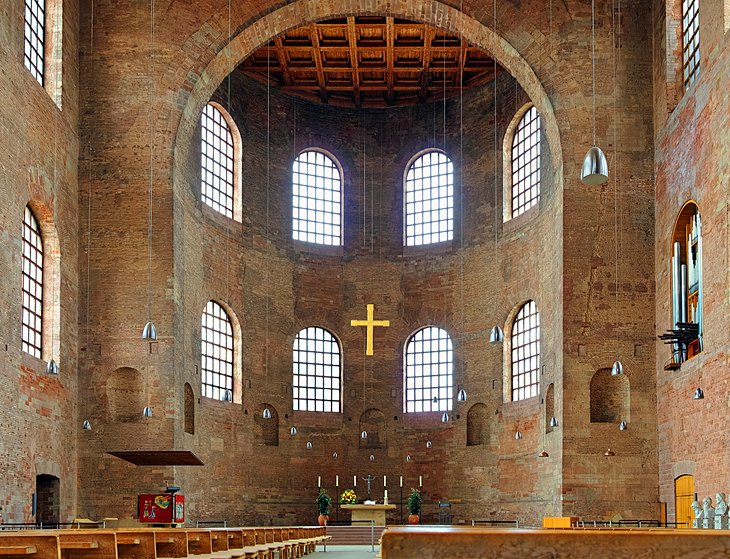
The Aula Palatina, also known as the Basilica of Constantine (Konstantin-Basilika), is a Roman basilica built in the time of Emperor Constantine, who resided in Trier from 306 to 312 CE. A rival to the cathedral for dominance of the city's attractive skyline, this amazing structure has been fully restored and now serves as the Protestant Church of the Redeemer.
It's also where you'll find the world's largest ancient hall, Constantine's Throne Room. This impressive hall measures 67 meters long, 27 meters wide, and 33 meters high. For a truly memorable experience, try to time your visit to coincide with one of the classical or choral concerts that are frequently held in this ancient venue.
Address: Konstantinplatz 10, D-54290 Trier
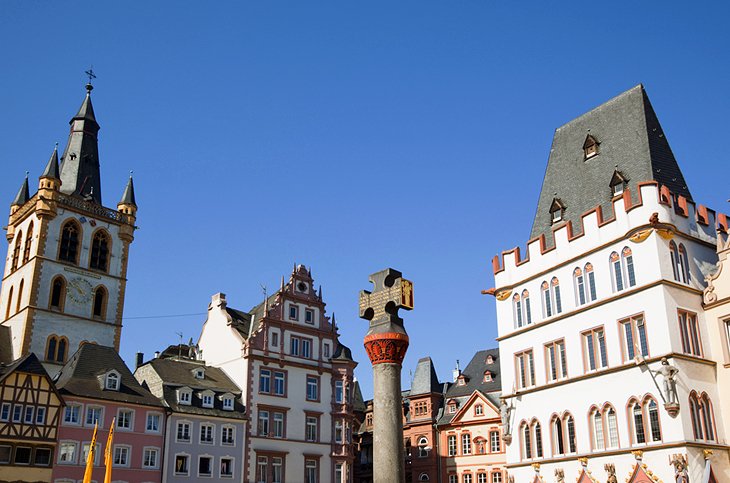
Once you've had your fill of a few of Trier's many magnificent Roman sites, make a beeline for the town's historic Market Square, or Hauptmarkt. Just a short walk from the Porta Nigra, it's a great place to break up your sightseeing with a stop at a café or restaurant.
In addition to its numerous lovely half-timbered buildings, Trier's beautiful old Market Square is where you'll find many fine historic medieval attractions. These include the 15th-century Steipe , home to the city's banqueting house.
Other highlights include the Late Gothic St. Gangolf's Church , as well as the spectacular Market Fountain (Marktbrunnen), built in 1595 and depicting St. Peter surrounded by the four virtues of Justice, Strength, Temperance, and Wisdom - along with a number of mocking monsters.
Other notable points of interest located in or close to the Hauptmarkt include the Frankenturm, an impressive 11th-century residential fortress built to house city dignitaries. Also worth seeing are the attractive 13th-century House of the Three Kings (Dreikonigenhaus), and the Judenpforte, the gateway that once led into the city's Jewish quarter, the Judengasse.
The fascinating Toy Museum (Spielzeugmuseum) is also of interest here. It's home to more than 5,000 antique toys, including dollhouses, model trains, and a 130-year-old French dancing bear. Market Square is also where you'll find regular markets selling goods and produce, as well as the city's popular Easter markets.
Trier is also widely considered one of the best places to visit in Germany in winter . Not only does the city get one of the country's heaviest levels of snowfall, but it's also home to one of the prettiest Christmas markets thanks to its being held in the Market Square with the cathedral as a backdrop.
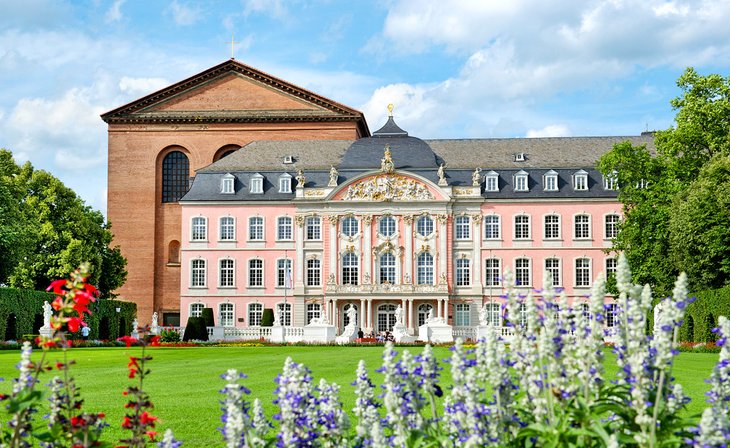
Trier's old Electoral Palace (Kurfürstliches Palais) is also worth seeing. Built in the 17th century and now used by local government offices, its courtyard, staircase, and Baroque room are open to the public during business hours. In the grounds are the charming Baroque Palace Garden (Palastgarten), framed by the palace and the massive basilica on one side.
Highlights include a number of attractive ponds and fountains and neat flower beds surrounded by beech hedges of various heights. A miniature garden is also open to the public.
An easy walk away are the Imperial Baths , as well as a café at the neighboring Archeological Museum (Archeological Museum) which offers great views over this large green space. Other public spaces worth visiting are Nell's Park , on the northern outskirts of the city, and the Mosel Embankment adjacent to the river, home to pleasant walkways, excursion boat docks, and an enclave of old fishermen's homes, many of them now restaurants, galleries, and shops.
Address: Willy-Brandt-Platz 3, 54290 Trier
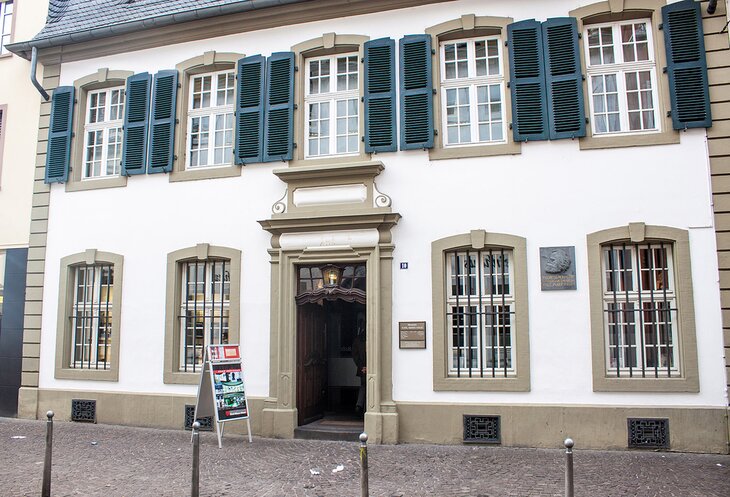
The birthplace of one of the world's best-known philosophers, Karl Marx House (Karl-Marx-Haus) has been a museum outlining the history of Communism and the famous German's life and writings since 1947. It was built in 1727, and Marx was born here in 1818. This is where he spent the first year of his life.
Highlights of a visit include exhibits detailing the rise of Communism and its social impact in the former Soviet Union, Eastern Europe, and Asia. Perhaps not surprisingly, the museum is particularly popular among Chinese tourists.
Artifacts of interest include original letters written by Marx, as well as the old armchair in which he reputedly did much of his reading. Audio guides are available upon request, as are interesting tours of the museum and Trier landmarks known to have been visited by Marx. Also worth a visit are this old Baroque property's lovely gardens.
Address: Brückenstraße 10, D-54290 Trier
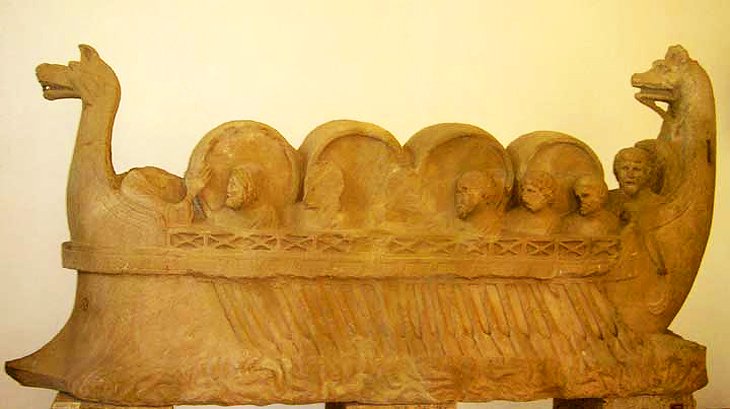
Widely regarded as Germany's most important archeology museum, the Rhineland Federal State Museum (Rheinisches Landesmuseum Trier) was established in 1877 to document some 200,000 years of the region's history. It covers the period from prehistoric times to the beginning of the 19th century.
Among its collection of more than 4,500 archaeological artifacts, many of them excavated by museum staff, are a large number of Roman mosaics, ancient stone burials, and the largest hoard of Roman gold coins ever discovered.
A highlight of a visit is viewing the dazzling twice-daily multi-media show, which describes the history of select exhibits and artifacts, placing them in the context of the period. Also worth spending time exploring is the huge scale model of Roman-era Trier.
English-language audio and guided tours are available, and the on-site shop sells a variety of great books related to the city's history.
Address: Weimarer Allee 1, 54290 Trier
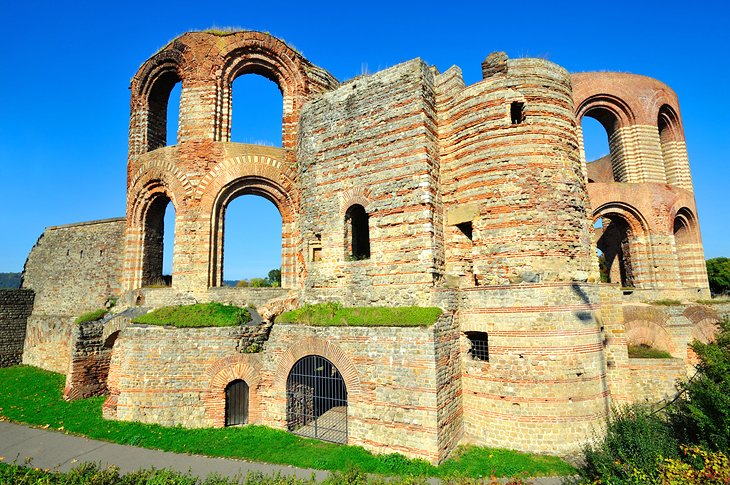
South of Trier Electoral Palace are the ruins of the Roman Imperial Baths, or Kaiserthermen. Dating from the 4th century, the baths were at the time one of the grandest such structures in Europe and were later converted into a fortified castle in medieval times. Despite this, much of the original Roman baths, the largest in Europe from this period, can still be seen.
Highlights of a visit include exploring the extensive complex of underground rooms and passages, as well as a visit to the vast hot-water bath. Once heated by six huge boilers, it was capable of holding over 600 bathers. Fun guided tours led by costumed staff are available.
Also of interest are the Forum Baths (Viehmarktthermen), dating from AD 100 with two hot-water baths, a perfectly preserved cold-water bath, and a museum. Another Roman site worth visiting is the Amphitheater just outside the old city walls and built around AD 100 with seating for 25,000.
Address: Weber Bachstr 41, 54290 Trier
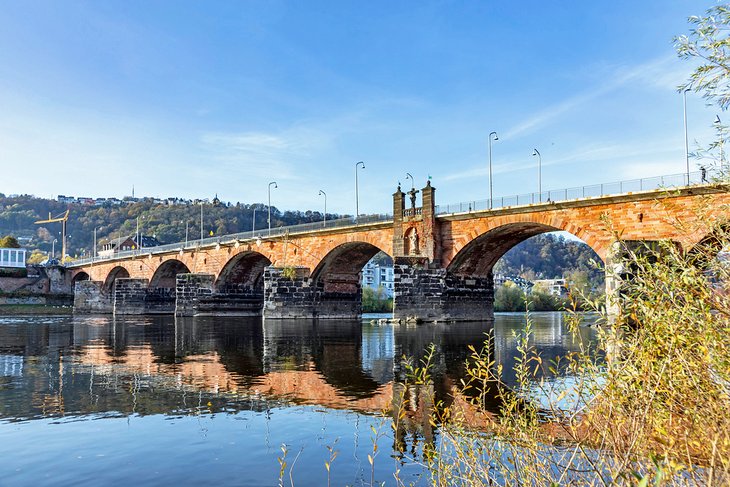
Another important landmark left behind by the Romans that's well worth exploring is the Roman Bridge (Römerbrücke). The oldest still standing bridge in Germany, it's still in use by motorized traffic and makes for a pleasant stroll with superb views over the Mosel.
While the upper portions of the bridge have been rebuilt a few times due to damage by war, most significantly in the 12th and 18th centuries, the nine pillars that still support the structure were built by the Romans more than 1,800 years ago.
Address: Römerbrücke, 54290 Trier
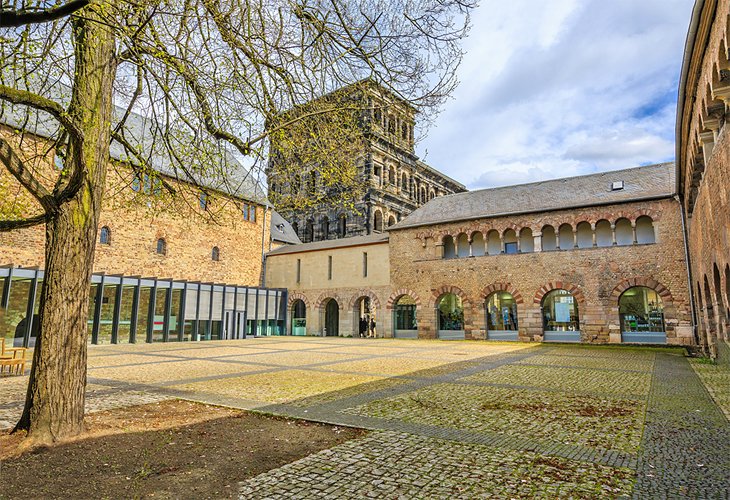
Those wanting to learn more about the rich cultural history of Trier and the surrounding area would do well to visit the City Museum Simeonstift (Stadtmuseum Simeonstift Trier). The building itself was the former monastery of St. Simeon and is handily located next to Porta Nigra. It's of interest for its two well-preserved cloisters and dates back to the 11th century.
Established in 1905, the museum features numerous interesting exhibits of artifacts dating from Roman times right up to the present day. Highlights include rare artworks, such as sculptures and paintings, local crafts, and textiles, as well as an impressive collection of antique furniture.
English language audio guides are available, including a version geared toward children. Private English-language guided tours for groups are also available, but be sure to contact the museum in advance for reservations.
Also worth visiting is the refurbished Treasury of the Trier City Research Library . Among the library's extensive collection of antique and rare manuscripts, regarded as one of the most valuable such collections in Europe, are the Gutenberg Bible , the world's first printed encyclopedia, and a rare almanac dating from the late 15th century.
Also of note are numerous medieval texts, rare volumes from the likes of Karl Marx and Goethe, and a collection of exquisite Baroque globes.
Address: Simeonstraße 60, 54290 Trier
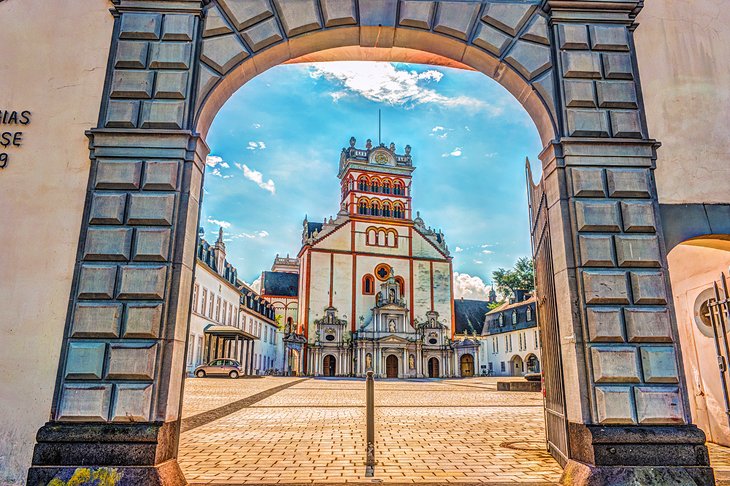
Constructed in 1127 and the site of Germany's first church, St. Matthias' Abbey is another must-visit tourist attraction in Trier. Famous as the supposed home of the remains of the Apostle Matthias, the abbey has for centuries been a place of pilgrimage for its many important Christian relics housed in the Cross Chapel (Kreuzkapelle).
The chapel takes its name after a piece of the cross, the Staurotheke, to which Christ was nailed, and which is now part of an elaborate artwork. It's well worth undertaking the guided tour of the chapel in order to view it.
It's an especially attractive church thanks to the many Baroque flourishes added in the mid-17th century, plus later Italian- and French-styled touches added in the early 1700s. Interior highlights include the decorative nave and aisles, and the old crypt.
If you happen to be traveling around the region by car, especially along the Mosel River, you'll also notice the historic "Matthias' Farms" (Mattheiser Hof), once important resources for the abbey in terms of income and produce. You can visit one such farm in Konz-Karthaus, the Roscheider Hof, a fascinating open-air museum, which offers a unique insight into the workings of these traditional farmsteads.
Address: Matthiasstrasse 85, 54290 Trier, Germany
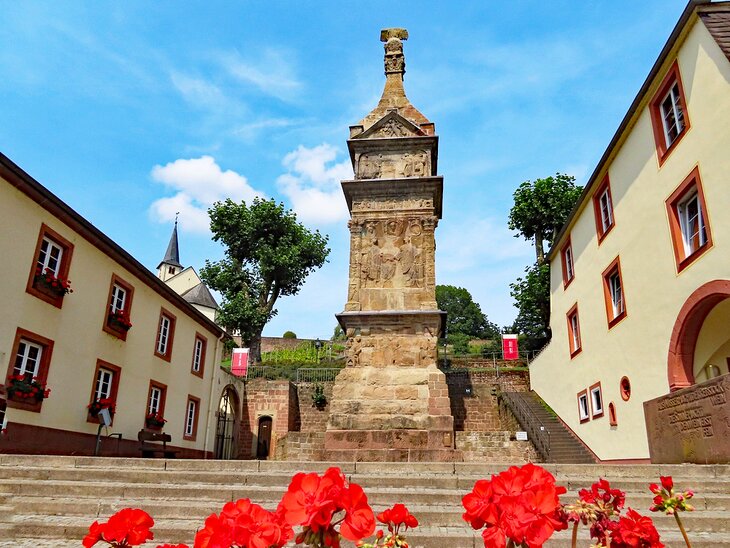
Given its location on the beautiful Mosel River, Trier makes a wonderful springboard for easy road trips into the surrounding countryside. Highlights include a visit to Konz , at the junction of the Saar with the Mosel and just eight kilometers southwest of Trier. Konz is famous for its open-air museum, Roscheider Hof , with its displays of traditional German culture.
Also worthy of a visit is the quaint village of Igel , another kilometer south of Konz. It's famous for the Igel Column , a funerary monument standing 30 meters high with richly-carved decoration built to commemorate an affluent Gallo-Roman family in the 3rd century.
More Roman architecture awaits at Nennig , 40 kilometers southwest of Trier by way of Saarburg and Remich. Here, you'll see the remains of a Roman villa discovered in 1852. Its stunning mosaic pavement, measuring 10 meters by 16 meters, is one of the largest and finest north of the Alps.
A winding yet extremely attractive 30-minute drive east of Trier is the interesting Fell Exhibition Slate Mine (Besucherbergwerk Fell). Now run as a museum, this disused slate mine, also known as the Barbara-Hoffnung Exhibition Mine, consists of two former roof slate mines. The oldest, the Hope mine (Hoffnung), was established in the 1850s, while the newer mine, Barbara, named after the patron saint of miners, opened in 1908.
It's a lot of fun exploring the mines as part of a one-hour guided tour, which includes a chance to scale a unique 100-meter-long stairwell that connects them. Along the way, you'll learn about the hostile conditions faced by miners, who often went for days without seeing sunlight during the winter months.
Be sure to also spend time exploring the slate mining trail, which leads past numerous old relics from the mine. There's also an information center on-site, which houses a variety of related artifacts and tools, as well as informative displays and multimedia presentations.
Address: Auf den Schiefergruben, 54341 Fell
Luxury Hotels :
- Located just a few minutes' walk from Trier's top tourist attraction, Porta Nigra, the ritzy Park Plaza Trier is a delightful luxury hotel located in the heart of the old city, boasting wonderful staff, elegant modern décor, and a superb wellness area.
- Other top luxury hotel options include the classy Hotel Villa Hügel Trier , popular for its larger suites and apartments (some with kitchenettes), and Romantik Hotel zur Glocke , a great choice for couples for its plush, intimate wood-beamed bedrooms and oversized bathtubs.
Mid-Range Hotels :
- A good choice in the mid-range category, ibis Styles Trier comes with fresh décor with a unique Roman theme and a sumptuous free breakfast.
- Mercure Hotel Trier Porta Nigra also offers a high level of quality along with its affordable rates and is ideally positioned right across from Porta Nigra. It also features a good restaurant with city views, along with tea and coffee makers in its rooms.
- Although a little farther away from the old city center, the FourSide Plaza Hotel Trier makes up for it with its riverside location on the Mosel, along with its larger rooms and suites.
Budget Hotels :
- Hotel Feilen Wolff is a great choice of a budget hotel in Trier. It's located directly across the river from the city, with free breakfasts and clean rooms.
- Other good budget hotels to consider include Hotel Deutscher Hof Trier , popular for its laid-back ambience and pleasant décor, and the ante porta Das Stadthotel , offering clean rooms within an easy walk of the city's most important historic sites.
More Related Articles on PlanetWare.com
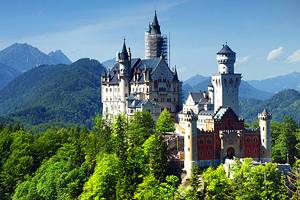
Exploring the Area : Trier's location in the Mosel Valley makes it a great location to explore other top destinations in this beautiful region of western Germany. It's just 1.5 hours west of the highlights of Koblenz, where the Rhine and Mosel rivers meet, making this a perfect jumping-off spot from which to take a riverboat to explore the equally attractive Rhine Valley region .
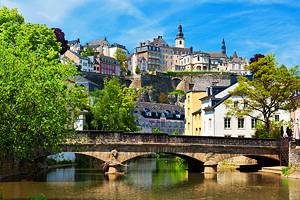
Travel Europe : Thanks to its position on the western-most border of Germany, Trier is also a handy jumping-off point for other interesting European cities. Luxembourg is less than an hour's drive, and a visit to this small country's historic capital city of the same name is well worth the effort.
The city of Metz in France is just an hour south, and is popular for its excellent museums, art galleries, and its cathedral.
And just two hours' drive north, you'll find yourself in Liège , one of the most beautiful old cities in Belgium .
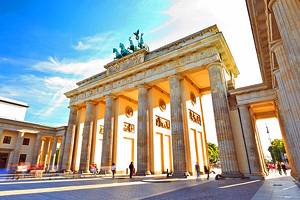
Germany Travel Ideas : Those traveling to Trier will often combine other top German destinations in their travel itineraries. The capital city of Berlin is a must-visit, especially for its historic Museum Island cultural district.
Other parts of this large and diverse country include neighboring Potsdam , the former preferred home to the country's old Prussian rulers, and Dresden , one of Europe's greatest Baroque cities.

More on Germany

The Complete Guide to Trier, Germany
:max_bytes(150000):strip_icc():format(webp)/ebephoto-5b7352c3c9e77c005080d5ad.jpg)
A Bit of History
Things to do, where to stay, what to eat and drink, trier travel tips.
On the banks of the Moselle River, just 6 miles from the Luxembourg border and 120 miles southwest of Frankfurt , lies Trier, Germany's oldest city. Founded as a Roman colony by Emperor Augustus in 16 B.C., evidence of Roman times still lingers in the city, giving it the nickname "Rome of the North."
Trier was also the birthplace of Karl Marx, and today features nine UNESCO world heritage sites ; as such, it has more than earned its ranking as one of Germany's top destinations . From things to see and do to where to stay, discover ancient and not-as-ancient history with our complete guide to Trier.
The first traces of humans in the region around Trier date back to the early Neolithic period. It wasn't until 16 BC, though, when the Romans founded the city of Augusta Treverorum, which became the foundation of modern Trier. Called Roma Secunda, the second Rome, it was the favored residence of several Roman emperors.
A mint was established, along with a stadium and amphitheater. The massive city wall built in AD 180 sought to protect it, but like most great cities, it fell and was rebuilt many times. In the 5th century, Trier was under Frankish rule and becoming increasingly Catholic; when the Vikings conquered the city in 882 and destroyed many of the churches and abbey, this period in history came to an end.
As Trier is located close to the French border, the effects of the Thirty Years' War had harsh effects on the city in the 1600s. The French occupied the entire area several times before Napoleon arrived in 1804 and made the city a diocese. During the First World War, Trier became a French garrison city with its major, Charles de Gaulle. The Second World War resulted in more destruction and subsequent rebuilding.
And yet, so much of the city—including the magnificent Trier Cathedral (Trierer Dom) and Imperial Baths (Kaiserthermen)—survived all of this. Trier celebrated its 2035th birthday in 2019 and continues to stay youthful and vibrant as a university city that welcomes thousands of visitors every year.
Trier is rife with attractions for architecture lovers and history buffs. Here are the top things to see and do during your trip to Germany's oldest city.
Porta Nigra
The highlight of Trier is the Porta Nigra (black gate), the largest Roman city gate north of the Alps. Dating back to AD 180, this UNESCO World Heritage site looks much the same as it did when it was first built, though it did undergo reconstruction by order of Napoleon. Visitors can walk between the 7,200 massive sandstone blocks just like the Romans did and take guided tours from a centurion in the summer. The "Secrets of the Porta Nigra" tour brings the Roman story to life with live performances starring emperors, barbarians, knights, and bishops.
Cathedral of Trier
The High Cathedral of Saint Peter in Trier (Hohe Domkirche St. Peter zu Trier ) was originally built by Constantine the Great, the first Christian Roman Emperor. The oldest church in Germany , it houses great works of art and a relic that draws many pilgrims: the Holy Robe, the garment said to be worn by Jesus when he was crucified. Since 1986, it has been listed as part of the UNESCO World Heritage attractions in Trier.
Basilica of Constantine
The Aula Palatina basilica was first commissioned as a throne room by Emperor Constantine I around AD 310. In the 19th century, Frederick William IV of Prussia transformed it into an impressive Protestant church featuring massive 108-foot-tall ceilings, black-and-white marble floor, and a modern floor-heating system. Today, over a thousand people gather here for church services.
Imperial Baths
Visit the ruins of the largest Roman baths outside Rome, the Imperial Baths (Kaisertherme), built 1600 years ago as a gift to the public. Extraordinarily grand for its time, the Kaisertherme featured an underground water heating system, and also functioned as a fortress, city wall, and monastery.
Main Market of Trier
The Main Market (Hauptmarkt), the city's main square, is located in the historic Old Town, designated a "Center of Antiquity." Here you'll find picturesque half-timbered houses, the city church, the cathedral, a medieval fountain and the Jewish quarter of Trier (Judenviertel). Look for the red house which dates back to 1684 and features inscriptions stating that Trier is 1,300 years older than Rome. A centerpiece is the Market Fountain from 1595, which depicts St. Peter surrounded by the four cardinal virtues of good city government—Justice, Strength, Temperance, and Wisdom—as well as monsters and, oddly, monkeys. Take note of the replica of the original stone cross that dates back to 958 and is now in the City Museum.
Karl Marx House
Visit the birthplace of Karl Marx, the father of communism, who was born in Trier in 1818. His former house is now a museum, and displays rare editions of Marx’s writings, communist teachings, and Marx's life in Trier up to his death in London.
The House of the Three Magi
Dreikönigenhaus, or The House of the Three Magi, showcases a fanciful Moorish design that stands out from its sober neighbors on Simeonstrasse. Built around 1230, it has undergone many changes throughout the ages, including removing the original ladder that was the only way to reach the upper floor. However, it still provides some unusual eye candy and a café on the ground floor.
Archaeological Museum
The Rheinisches Landesmuseum (RLM) offers some of Trier’s most impressive Roman artifacts and artworks from the region. The museum's collections of sculptures, mosaics, and frescos are among the best in Germany, and it also features a multimedia presentation, "In the Realm of Shadows."
Trier Amphitheatre
Located just outside of the center of town, the Trier amphitheatre was once the center of Roman entertainment. Over 18,000 spectators would cheer on bloody battles between gladiators and animals, as well as the usual gathering or religious celebrations. Today, visitors can explore the arena, including its stands and cages. A short walk away there is an excellent panoramic viewpoint at Petrisberg.
As a destination city, Trier has a range of accommodations, from modern boutique hotels to traditional pensions (B&Bs). A bonus is that many of the hotels also feature excellent dining facilities.
- Hotel Villa Hügel : An elegant four-star Art Nouveau hotel with a sauna, pool, and on-site restaurant serving upscale regional cuisine. Ask for a room with a terrace or balcony.
- Romantik Hotel Zur Glocke : Housed in a former residence constructed in 1567, this central hotel is warm and inviting with friendly staff. Many rooms offer views of the Cathedral of Trier.
- Ibis Styles Trier : A 10-minute walk from Trier's main sites in Kornmarkt Square, this design hotel is located within a former post office. It offers modern amenities, including a small fitness room and free WiFi.
- Hotel Eurener Hof : This historic hotel is located near the city center and boasts rooms with French doors leading to private terraces. The on-site restaurant pairs local specialties with great wine.
- Berghotel Kockelsberg : This regal hotel is outside the city on a hill overlooking the Moselle. Along with peaceful rooms, it has an excellent restaurant and outside terrace with panoramic views.
Trier's location within the lush Moselle valley and its close proximity to Luxembourg and France mean the dining options are positively luxurious. Here you'll find regional takes on German classics , like klöße (potato dumplings) often served stuffed, teerdisch (mix of potatoes, sauerkraut, and bacon), and flieten (chicken wings).
As the Moselle valley is known for its award-winning rieslings, Trier is the perfect place to start your wine tour. Take a boozy stroll of the Trier Wine Culture Trail , or enjoy the numerous varieties of wine served in Trier's many Weinstube.
Here are the best places to sample the city's culinary scene:
- Weinstube Kesselstatt : An authentic Trier dining establishment with hearty meals paired with dazzling Moselle Valley Rieslings. Visitors can bask on the terrace under romantic vines when the sun is shining, while poor weather is a great excuse to get cozy in the vaulted cellar.
- Becker’s : This is Trier's only Michelin 2-starred hotel restaurant. Contemporary and cool, it has a traditional weinhaus and gourmet restaurant.
- Weinstube Zum Domstein : Centrally located in the Hauptmarkt, charming Domstein claims to be the oldest club dedicated to classics like spießbraten .
- Schlemmereule : With an elegant ambience and cuisine from France, Luxembourg, and greater Europe, Schlemmereule's fine dining experience begins as soon as you enter the door.
- Brasserie Trier : A French-style brasserie around the corner from the main square, this restaurant has an effortless approach to timeless classics.
- Das Weinhaus : The focus here is on the region's legendary wine. Knowledgeable staff can guide diners through the many award-winning rieslings, Muller-Thurgau, and pinot grigios paired with German delicacies like käsespätzle and teerdisch.
- Der Daddy Burger : If you've had your fill of German food, Der Daddy has the best burgers in Trier, utilizing local products like freshly baked buns.
- City Tours (in English): There are several different options for city tours, whether you are looking for a hop-on-hop-off bus or walking tour. Some focus on specific attractions, whereas others provide an overview of the city. The Tourist Information Offices will help you decide on the right tour for you.
- In the Region : Plan a side trip to one of Germany's best castles, Eltz Castle , just 45 miles northwest of Trier. Visitors can also cross the border to Luxembourg , which is only 9 miles away.
- Festivals : Trier's Altstadtfest is a highlight of the year; this folk festival happens every June, and features more than 100 stalls of food and local products in addition to live music. In July, there is the Trier Handwerkermarkt , where you'll find a hundred stalls of handmade crafts such as soap, jewelry, and fabric. The holiday season is another high travel time for the entire country, and Trier puts on one of the best Christmas markets in Germany .
The Best UNESCO Sites in Germany
Regensburg: Planning Your Trip
Best Destinations in Western Germany
13 European Rivers and Waterways to Cruise
Top 10 Attractions in Germany
The 11 Best Things to Do in Bonn, Germany
Best Underrated Cities in Germany
15 Best Castles and Palaces in Germany
16 Best Free Things to Do in Cologne, Germany
Germany's Wine Road
The Top 8 Things to Do in Boppard, Germany
The 14 Best Day Trips from Rome
The 25 Top Attractions in Rome, Italy
The Essential Guide to Alsace, France: What to See & Do
Essential Ancient Sites to Visit in Rome
Lübeck: Planning Your Trip
results Sorry, we didn't find a result for you!
${doc.teaser}
Trier - your city experience!
A fresh look at trier.
The Mosel metropolis of Trier is best known for its ancient UNESCO World Heritage Sites, and particularly for its Roman city gate, the monumental Porta Nigra. The city’s pedestrian zone with its wealth of historic buildings is a great place to wander and shop. Plus,Trier is also a university town, full of young, and young-at heart, creative minds! There’s plenty to discover in the way of good food too, with modern cuisine inspired by nearby Luxembourg and France. And of course you’ll also find first-class wines here from the world-famous Mosel winegrowing region.
Just by wandering through the pedestrian zone you’ll almost inevitably pass by some of the city’s most notable sights: the Porta Nigra, Trier Cathedral, the Liebfrauenkirche (Church of Our Lady), the Constantine Basilica and the Imperial Baths (all UNESCO World Heritage Sites). And just a short walk from the pedestrian zone will take you to the Amphitheatre , the Barbara Baths and the Roman Bridge , all of which are also UNESCO-listed . On the Viehmarktplatz , a dramatic glass building designed by architect Oswald M. Ungers showcases the city’s history. The spatial experience inside is incredible! Ungers is also responsible for the impressive plaza by the Constantine Basilica, and the monumental visitors building at the Imperial Baths is also down to him and his team.
Fancy a guided tour of the city? The Tourist Information Trier offers guided tours in English from April to October always on Saturdays at 1 pm.
Key museums
Trier has several museums to offer with special collections and exhibits, first and foremost the Rheinisches Landesmuseum and the Museum am Dom . Here you will find important finds from the ancient UNESCO World Heritage Sites and the Trier region, such as the Constantinian ceiling paintings .
In the Stadtmuseum Simeonstif t at the Porta Nigra, you can learn everything about the history of the city and its cultural heritage.
There are, however, two very special treasures that you also need to see. The medieval Egbert Codex an the Ada Gospels which are listed on the UNESCO Memory of the World Register , are on display alongside other rare books at the Treasury of the Trier City Research Library . The Egbert Codex is considered to be the most important work of the Ottonian era and the oldest and most comprehensive cycle of images on the life of Jesus. The Ada Gospels is a masterpiece of Carolingian book illumination that gives us an insight into the cultural heyday under Charlemagne.
Did you know that Karl Marx was born in Trier? His birthplace, Brückenstraße 10, houses a museum with a permanent exhibition where you can find out about Karl Marx as a person, his achievements as a 19th century critic of society and capitalism, as well the legacy of his ideas into the present day.
Modern art & culture
The European Academy of Art is a great choice for modern art. Working together with the University of Trier and the Trier University of Applied Sciences, the academy has also created a database of art in public spaces and has designed accompanying tours that can be accessed by smartphone. These are available online and the convenient thing is that Trier's pedestrian zone offers free Wi-Fi. The city centre features various galleries with interesting temporary exhibitions, such as the Galerie Netzwerk mit Garten (Neustraße 10), the Galerie KM9 ( Karl-Marx-Straße 9) and the Galerie Junge Kunst ( Karl-Marx-Straße 90). Directly adjoining Neustraße is an iconic former kiosk that now serves as a modern exhibition showcase (Südallee / corner of Saarstraße).
And another tip: You should also check out the modern church of St. Michael in the Mariahof district, a stepped pyramid structure designed by architect Konny Schmitz in 1968/69. Otto Herbert Hajek designed the church’s altar island as a walk-in sculpture, and created the image sequence "Zeichen am Wege" as well as twelve vault panels in intense primary colours. These explore the divine hope of salvation, the New Jerusalem, and the seven angels described in the Book of Revelation.
Exceptional gifts and mementoes
Trier is a very popular shopping destination, even its Luxembourg neighbours like to shop there. It’s so easy to wander from one store to the next. You’ll find retail chains like everywhere else, but also stores that are run by their owners. The fashion design department at the Trier University of Applied Sciences has given rise to several stores where f ashion designers sell their extravagant creations.
Almost all of these can be found on Neustraße , a great place for all things creative in general. The designer Tanja Kriebel runs her boutique over at Jakobstraße 33.
Culinary tips
Select restaurants.
One star in the Michelin Guide and 17 points in the Gault Millau; if you’re looking for a top culinary venue in Trier, then Becker’s in the Olewig district is the place for you. Directly opposite Trier Cathedral is where you’ll find the restaurant "Schlemmereule" , where cuisine is inspired by nearby France and Luxembourg. Its wine list includes over 200 wines from the best Mosel wineries.
Another recommendation is the restaurant at Castle Monaise . The grand neoclassical building is a delight in itself! It was built around 1780 as a summer residence for the dean of Trier Cathedral, Philipp Franz von Walderdorff, and is believed to be the only Louis XVI building on German soil . The name is derived from the French "mon aise", which translates as "my comfort". The restaurant’s menu offers a successful mix of classic French, Mediterranean and regional cuisine.
A new addition to the Michelin-starred sky since 2023 is the Bagatelle directly at Zurlauben with chef Gerald Schöberl. With a unique view of the Mosel, he spoils his guests with modern cuisine shows classic French influences and interesting Japanese accents.
Select vinotheks
If you want to get a good impression of the best wines available in the Mosel region, there are numerous vinotheks and wine taverns to choose from. The vinothek Das Weinhaus (Brückenstraße 7) has an extensive selection of Mosel wines from renowned wineries on its list, true to the saying, “Life is too short to drink bad wine”. Other great choices for wine lovers include the Weinstube Kesselstatt across from the Liebfrauenkirche, the extensive selection of wines at Weinhaus Oechsle (Palaststraße 5-7) and the Weinwirtschaft Friedrich Wilhelm (Weberbach 75). A wander through the city is guaranteed to present you with even more quality options.
Nightlife, concerts and festivals
A city like Trier naturally also offers a great nightlife . We’d like to recommend one club in particular: the VillaWuller , Ausoniusstraße 2. There’s house music to lose yourself in and regional DJs spin their discs alongside those from cities such as Cologne, Leipzig, Berlin, Hamburg, Frankfurt, Strasbourg, Brussels, London and Bristol.
Trier offers great concerts and festivals !
Particularly atmospheric are the open-air concerts in front of a great backdrop, such as Porta³ on the Porta Nigra forecourt, the concert series in the inner courtyard of the medieval Simeonstift right next door or the programme of the Zurlauben cultural harbour on the banks of the Moselle.
In autumn, you can look forward to the Trierer Unterwelten festival , which takes you into an unknown world of cellars and catacombs, tunnels and basements, excavations, garages and crypts. Every two years, the Illuminale light art festival transforms Trier above ground into a mysterious, magical world.
The organ concert series in Trier Cathedral transforms the venerable cathedral into a powerful sound space.
The moselmusikfestival also uses this UNESCO World Heritage Site as well as other historic venues, including Trier Cathedral, the Liebfrauenkirche, St. Gangolf and the Electoral Palace (courtyard and rococo hall) for outstanding concerts.
Sweet dreams
Our accommodation tips
There are so many really good accommodation options to recommend. But we’d like to make you aware of two hotels in particular. The 4-star superior Park Plaza hotel is situated in the centre of Trier’s pedestrian zone. The hotel’s interior design and décor reflect the city’s unique character, i.e. its ancient heritage. Even the Relaxarium wellness facilities have a Roman look and feel. So, it’s a great starting point for exploring Trier’s UNESCO World Heritage Sites.
The 4-star superior Hotel Villa Hügel ranks among the 10 best hotels in Germany on rating sites, which is pretty impressive. The white Art Nouveau villa formerly belonged to a rich wine merchant family from the Mosel region and has been beautifully renovated. Its “Gastraum” restaurant is something of a food lovers’ insider tip, and Hotel Villa Hügel also has a lot to offer where wellness is concerned. Thanks to its hillside location, it offers a fantastic rooftop pool with panoramic views over the city. The city centre is easily reached on foot or by public transport.
Book your Mosel journey now!
It appears that you are using Microsoft Internet Explorer as your web browser to access our site.
For practical and security reasons, we recommend that you use a current web browser such as Firefox , Chrome , Safari , Opera , or Edge . Internet Explorer does not always display the complete content of our website and does not offer all the necessary functions.

26 Top attractions and Things to do in Trier, Germany
- David Angel
About the Author: David Angel is a British photographer, writer and historian with 30+years experience exploring Europe. His work regularly appears in global media including the BBC, Condé Nast Traveler, and The Guardian.
It’s Germany’s oldest city, with some of the greatest Roman monuments in Europe and the country’s oldest Cathedral. Not to mention some stunning medieval houses.
And yet Trier somehow feels off the beaten path, well away from the crowds. One reason it’s relatively quiet is that Trier is a little out on a limb, in the far west of Germany close to the border with Luxembourg.
My guide to the best things to do in Trier covers all the city’s ancient sites and much more. It includes one of the best open-air museums in Europe just outside the city.
I suggest the best day trips from Trier; one up the Saar valley and the other down the Mosel towards the Rhine to witness some of the most stunning landscapes in Germany.

Table of Contents
Why Visit Trier
- Trier is one of the best cities to visit in Germany. It is an ancient Roman capital with some of the finest Roman monuments in Europe to explore.
- It’s also one of the most beautiful cities in Germany, with some outstanding medieval architecture and one of the great cathedrals of Europe.
- Trier is also an excellent base for exploring the Mosel and Saar Valleys, as it’s close to the confluence of the two rivers.
- Other day trips from Trier include the short cross-border hop to the Grand Duchy of Luxembourg, one of the smallest and most beautiful countries in Europe.

Top Things To Do In Trier
1. explore porta nigra.

Porta Nigra Trier (Porta Nigra is latin for black gate ), is the symbol of the city, the sole surviving Roman gateway to Trier, which was built in the 2 nd century AD. It’s a magnificent structure on the northern edge of the city centre, one of four gates to the city. The others were most likely dismantled by locals who used the materials for other buildings in Trier.
Porta Nigra is an amazing feat of ancient engineering, consisting of a series of large stone blocks held together by metal clamps.
Porta Nigra ended up having something of an ‘afterlife’ in the 11 th century when a Greek hermit accompanied the Archbishop of Trier to the city and set up a cell in the Porta Nigra. He died a few years later, and after miracles were reported at his tomb, he was canonized.
The Porta Nigra was then converted into a pilgrimage church on two levels, which ensured its survival. Interestingly, it was used as a church until the 18 th century, and several Baroque bas-reliefs in the gateway are from this period.
Tickets: A single entry ticket costs €4 for adults, otherwise it can be visited as part of the Trier Antikencard . Discounts available for children, students, families etc.
Opening Hours: November – February: daily 9 a.m. – 4 p.m. March: daily 9 a.m. – 5 p.m. April – September: daily 9 a.m. – 6 p.m. October: daily 9 a.m. – 5 p.m.
Good to know: Last entry is 30 minutes before closing time.
Address: Porta Nigra, Simeonstraße 60, 54290 Trier

2. Visit the Cathedral of Trier

Trier Cathedral is stupendous. It’s one of the most magnificent churches in Germany, and one I had been looking forward to visiting for decades.
I must admit that seeing the amazing west front of the Cathedral for the first time, together with the Liebfrauenkirche next door, blew me away.
Trierer Dom – also known as the High Cathedral of St Peter in Trier – is the oldest cathedral in Germany. Christianity first came to the city by 270 AD, and the first church on the site was built by the early 4 th century.
Opening Hours:
November 1 to March 31: daily from 6:30 a.m. to 5:30 p.m.
April 1 to October 31 daily 6:30 a.m. to 6:00 p.m.
Good to know: Sightseeing is not possible during Mass.
Address: Liebfrauenstraße 12, 54290 Trier, Germany
3. Visit Liebfrauenkirche – Church Of Our Lady Trier

The Liebfrauenkirche is the finest of the churches in Trier after the Cathedral. The two share a magnificent cloister and garden, but the church was built after its neighbour, and was one of the earliest Gothic churches in Germany.
The church was built in French High Gothic style by French architects commissioned by the Archbishop of Trier, Theoderich von Wied.
An inscription inside the church states that it was constructed between 1227 and 1243, though the dates may not have been entirely correct.
The exterior, especially the western portal, is very impressive, but the interior is the highlight. The relatively short length of the church gives an impression of great height, and some of the painted vaults, especially that of the central tower, are breathtaking.
Address: Liebfrauenstraße 2, 54290 Trier, Germany

4. Discover the Hauptmarkt

One of the best things to do in Trier is to spend some time on the Hauptmarkt, its main square.
It’s one of the most beautiful squares in Germany, with views of three of the main Trier landmarks (Porta Nigra, the Cathedral and the church of St Gangolf) within sight.
It is surrounded by cafes and restaurants, and you also get a taste of traditional German architecture here with the gorgeous half-timbered houses from the late Middle Ages on one side of the square.
One of the most impressive buildings on Trier Hauptmarkt is Die Steipe, a 15 th century tower-house on the corner of the square.
It has an impressive series of sculptures, including the four patron saints of the city, Peter, Paul, Helena and James the Elder. The ground floor now houses a restaurant, Zur Steipe .

5. Visit Trier Toy Museum

I didn’t get to visit the Trier Toy Museum over the course of my two visits to the city, though I’m sure I would have if my son had been with me!
The little red car on the corner of the Hauptmarkt helps you to find it, in one of the buildings just off the square.
They have a large collection of over 5,000 toys, and if their eyes are glazing over at the prospect of another ruined Roman thermal baths, it’s the number one fallback option for things to do in Trier with kids.
6. St Gangolf Church

St Gangolf’s Church is one of the main landmarks in Trier, towering above the houses on the south side of the Hauptmarkt. It’s one of the most significant churches in Trier, and I was disappointed to find it closed for renovations.
St Gangolf (or Gangulphus) was a French saint with one of the most unusual stories I’ve come across. He was a rich knight from the Burgundy region who renounced much of his wealth and became a hermit.
His wife was not supportive of this, and she eventually conducted an affair with a priest. She and her lover eventually killed Gangolf, and both died soon afterwards.
He is now the patron saint of unhappily married husbands.
7. Three Kings House – Dreikonigenhaus

The Dreikonigenhaus is another Trier tower house, probably dating from the early 13 th century, around the time of the gradual crossover between Romanesque and Gothic architecture in Europe.
It’s located on busy Simeonstrasse, within sight of the Porta Nigra, and would have belonged to a family of considerable wealth. The most unusual aspect is its front door on the first floor – this would have been accessible by a wooden staircase or ladder.
8. Aula Palatina

The Aula Palatina, also known as the Basilica of Constantine, is one of the most impressive Roman buildings in Europe. It was completed in 310 AD, a brick basilica with the largest hall surviving from ancient times.
It is a vast building, 67 metres long and 33 metres high, with a superb wooden coffered ceiling. The Basilica later served as a residence for the Archbishops of Trier, and is now used by the Evangelical Church.
Don’t miss it, it’s one of the essential things to do in Trier.
9. Electoral Palace Trier

The Electorate of Trier was one of the most powerful parts of the Holy Roman Empire, and the Archbishop and Electors resided in a medieval fortress-palace and later a Renaissance palace.
The Palace extended beyond the adjacent Aula Palatina as far as the Red Tower, so much of the complex was lost over the centuries.
The southern part of the Palace was built in the mid-18 th century in the Rococo style (essentially a more florid form of Baroque).
The façade and Gardens are among the most striking things to see in Trier, and there are a couple of great cafes close to the Gardens where you can stop by.
Unfortunately the Palace is usually closed to visitors, but you can see inside if you happen to be in town for one pf the classical music concerts that are held there.
10. Trier Roman Amphitheatre

Like most major Roman cities, Trier had an amphitheatre, and it hosted events including gladiatorial contests and executions.
It’s the tenth largest surviving Roman amphitheatre, and had a capacity of around 20,000 spectators. It is still used for Roman re-enactments, and you can climb to the top of the seating area for superb views.
You can also descend into the cellar below the arena, where animals and prisoners would be kept.
The Amphitheatre is a few minutes’ walk up the hill from the Kaiserthermen, on the eastern side of the city below the Petrisberg vineyards.
11. Kaiserthermen – Trier Imperial Baths

The Kaiserthermen – Imperial Baths – are one of the most impressive things to see in Trier. I first glimpsed them from the train on my way into Trier, and was keen to see them up close.
They have a surprising story, as historians aren’t sure they were ever completed. They were begun in the 3 rd century AD, then work recommenced a century later.
It’s a large complex, with underground tunnels and ruins of baths and a large pool that would have accommodated hundreds of bathers. The Kaiserthermen later served as a fortress and monastery.
The Kaiserthermen can also be visited with the Antikencard.
12. Barbarathermen

The Barbarathermen bath complex, a few minutes’ walk along Sudallee from the Kaiserthermen, was considerably larger than its near neighbour, and indeed is believed to be the second largest baths complex in the Roman Empire.
The extensive remains are a fraction of the size of the original complex, and it takes a fair leap of the imagination to picture the Barbara Baths as they were. Some of the baths were heated, and even lined with marble.
When pondering the famous question, ’What have the Romans ever done for us?’ the rebels in Monty Python’s The Life of Brian really should have mentioned wellness and thermal spa treatments as well.
13. Römerbrücke – Roman Bridge

The Roman Bridge – or Römerbrücke – over the Moselle River is the oldest bridge in Germany. Astonishingly it dates from the late 2 nd century AD, and the nine pillars are all original.
It is part of the Trier World Heritage Site, along with the other Roman monuments in the city.
14. Zurlauben

One of the most enjoyable things to do in Trier that I found was the small Zurlauben riverside district just to the north of Trier city centre.
I visited on a hot summer’s day, so appreciated the opportunity to sit in the shade at a table at one of the pubs and enjoy a cool glass of Bitburger.
There are several pubs and restaurants along this short, picturesque street, and I recommend the outdoor tables during the warmer months for the great river views. Mosel river cruises also start from here.
15. St Matthias Abbey
St Matthias’ Abbey, in the south of Trier is unique in that it’s the only church north of the Alps to be the site of the tomb of one of the Twelve Apostles of Christ.
The relics were most likely donated by St Helena, mother of Emperor Constantine the Great, who was very supportive of the early Christian community in Trier. The church has attracted pilgrims since the 12 th century, when the relics were rediscovered.
Interestingly, the west front of the church has influenced other buildings in the city, most obviously the Dreikonigenhaus. The church is from the late Romanesque period (late 12 th century), and there’s an unusual smaller Baroque façade laid over the lower part of the west front.
16. Karl Marx Museum and Statue

19 th century political philosopher Karl Marx was born in Trier in 1818 and spent his early years in the city before moving away to study at the University of Bonn.
We had seen his tomb in Highgate Cemetery when we lived nearby in North London some years ago, so I was curious to see where his life journey began.
Marx was a very influential and also divisive figure, one of the most significant of the last 200 years. His Communist Manifesto influenced many, who believed in workers of the world rising up and seizing power.
Some aspects of his legacy are strongly disputed, but some things done in the name of ‘Marxism’ or ‘Communism’, such as the Soviet Great Purge or the Gulag prison camp system – weren’t suggested or implied in his works.
There are two things to see in Trier related to Marx – his statue and the Museum dedicated to him in his birthplace. The statue, near the Porta Nigra, by Chinese sculptor Wu Weishan, was inaugurated in 1918.
The Karl Marx Museum is in his birthplace on Bruckengasse, to the south of the city centre. The ground floor of the Karl Marx house, which his family left when he was a toddler, is devoted to his personal life
(and includes the armchair on which it is believed that he died), while the upstairs part of the exhibition examines his works and legacy.

17. Simeonstift Museum

The Simeonstift is a monastery next to the Porta Nigra, and it’s now home to the City Museum. The double-level cloister is a wonderful setting, often used for concerts in the summer.
The Museum itself is well worth an hour of your time. It copers the history of Trier from pre-Roman times to the present, and also has an impressive art collection.
The Museum also hosts regular temporary exhibitions – for much of 2023, a retrospective of local avant-garde artist Hans Proppe will be running.
18. Rheinisches Landesmuseum
If you came to Trier to see the Roman ruins then you should absolutely not miss the Rheinisches Landesmuseum . It covers the rest of the Rheinland Pfalz state as well as Trier, and is one of the richest archaeological museums in Germany, indeed Europe.
Its permanent collection covers the history of the region from 200,000 years ago to the 18 th century, and the oldest exhibits are early stone tools used by our very early ancestors.
The Museum is best known for its Roman-era treasures, including beautifully preserved mosaics and a vast hoard of gold coins discovered near Trier in 1993. Again, you can visit the Museum as part of the Trier Antikencard package.
19. Historic Trier River Cranes

There are two river cranes on the right bank of the Mosel river in Trier, which hint at its past as an important trading port.
The older of these dates from the 15 th century, and the one pictured, a short walk from the Barbarathermen, was built in 1774. You can’t go inside either of them, but they’re worth a brief look.
20. Roscheider Hof Open Air Museum

If you stay in Trier, and have any interest in 19 th and 20 th century history, I strongly urge you to consider a half-day trip to Roscheider Hof Open Air Museum , a few miles from Trier.
I grew up near one of the best folk museums in Europe, St Fagans near Cardiff in Wales, and have to say that Roscheider Hof is of a similar standard – perhaps not for presentation, but certainly for content.
It covers the Hunsruck, Saar, Mosel and Luxembourg borderland region. There is a re-created village of houses and shops rebuilt piece by piece, and a vast collection of re-created shops and homes from the 19 th and 20 th centuries.
It’s one of the best museums of its kind, a wonderful find.
Best Day Trips From Trier

Trier is close to the ‘SaarLorLux’ region (Saarland in Germany, Lorraine in north-east France and Luxembourg), so it’s on the edge of a western European mini-melting pot, with a great many places to see nearby, many of which are off the beaten track.
It’s less than an hour away from the Luxembourg town of Schengen, where the European open borders treaty was signed.
One of the best places to visit on a day trip is the Mosel town of Cochem. It is within easy reach from Trier, as little as an hour away by train. Cochem is dominated by its fantasy Reichsburg Castle, on a hill high above the town.
But there are many more things to do in Cochem , with a gorgeous old town, hikes in the hills and boat trips along the Mosel.

Beilstein is a tiny village a few miles upriver from Cochem, one we think is up there with the most beautiful villages in Europe. Like many Moselle wine villages, it’s a cluster of half-timbered houses huddled between a ruined medieval castle and steep vineyards.
Burg Eltz is one of the most famous castles in Germany, a fairytale fortress-residence in the hills above the Mosel.
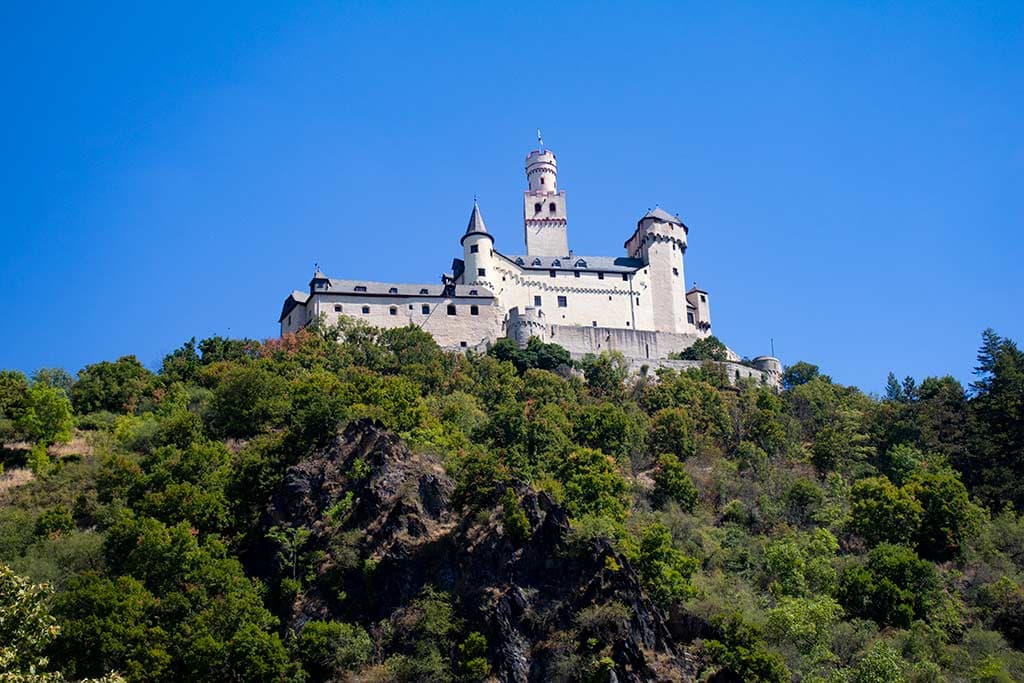
Trier is also within reach of Koblenz, the gateway to the Rhine Valley World Heritage Site. From Koblenz, you’re very close to Braubach , one of the most beautiful Rhine towns, which is below Marksburg Castle , one of the most impressive of all the Rhine River Castles .
See Also: Bacharach Germany – the most beautiful village on the Rhine

In the opposite direction, the Saar Valley is one of the least-explored areas of Germany, one to which we’d love to return. Top of our list is Saarburg, a gorgeous town with a waterfall running through its centre and a fine medieval castle overlooking the river.

We used the capital of Saarland, Saarbrücken, as our first base for our rail trip across Germany to Prague. There are enough things to do in Saarbrücken to keep you busy for a day or so, including one especially captivating Baroque church, the Ludwigskirche.

It’s one of the lesser-known World Heritage Sites in Germany, but I cannot recommend Völklingen Ironworks enough. It’s a completely preserved Ironworks which closed in the 1980s, an incredible place to visit.
Parts of it are used to exhibit art, others are part of the artwork. Some of it is left to nature, and you can climb a network of stairs to the top of the blast furnaces for amazing views over the complex.
What to do in Trier Germany in Winter
Visit Trier’s Christmas Marke t in the main market square, one of the oldest in Germany, and one of the most atmospheric. Don’t miss seeing the ancient Porta Nigra gate, beautifully lit up in the winter evenings.
A Brief History of Trier
To fully appreciate a visit, it is important to have some historical background information about Trier.

The Treveri Celtic people occupied the area that is now Trier some time in the last centuries before the birth of Christ and establishment of the Roman Empire.
Roman forces led by Julius Caesar subjugated the Treveri, and a settlement, Augusta Treverorum, was inaugurated around 16 BC. The name means ‘City of Augustus among the Treveri’ and the city is believed to be the oldest in Germany.
Trier grew in prominence during the 1 st and 2 nd centuries AD, becoming capital of the province of Belgica and, later, Gallia Belgica. Many of Trier’s best-known landmarks, including the Porta Nigra gateway, were added during this period.
Trier was the second city after Cologne, then Colonia Agrippina) of the short-lived breakaway Gallic Empire between 271-274 AD. It was also ransacked by the Alemanni soon afterwards.

It was then made a residence of the Western Roman Emperors in 293, a status that was maintained for over a century. This conferred great prestige on the city, and more grand buildings followed, including the Aula Palatina (Basilica of Constantine) and Kaiserthermen (Imperial Baths).

Trier was also the oldest Christian community in what is now Germany, dating back to as early as 270 AD. The first church on the site of Trier Cathedral was also built in the early 4 th century AD.
St Helena, mother of the first Emperor to convert to Christianity, Constantine the Great, was an important patron of the Church in Trier, donating significant relics such as the Holy Robe, which would attract pilgrims to Trier centuries later.
As the Roman Empire gradually disintegrated, Trier came under more frequent attacks. The Franks sacked the city four times, and eventually took over until 843.
The city declined in importance, and its population fell from up to 80,000 citizens to around 5,000.

After being incorporated into the Kingdom of Lorraine and then the East Frankish Empire (which would eventually form part of modern Germany), Trier was ransacked by the Vikings in 882 AD.

Trier remained a significant ecclesiastical power, and the relics of the Apostle St Matthias were held in the Abbey dedicated to the saint in the south of the city.
The Archbishops of Trier were one of seven Electors of the Holy Roman Empire, and their interest spread to include territory and castles to the east (Including Burg Maus, in the Rhine Valley).
Baldwin of Luxembourg was one of the most important Archbishops of the Middle Ages, instrumental in the growth of power in the mid-14 th century.
Trier was captured several times over the course of the 17 th century, and again in 1794 when it was incorporated in to France.
The Prussians then took over in 1814, and four years later one of the most influential people of the following 200 years, a certain K. Marx, was born in the city.
Trier developed as a trading centre and port during the 19 th century, and is now the fourth largest city in the Rhineland-Palatinate.

St Helena, mother of Constantine, the first Roman Emperor to convert to Christianity, was a patron of the church, and donated two significant relics, the Holy Robe (worn by Jesus during the crucifixion) and the Holy Nail used on either his feet or one of his hands to keep him on the cross.
The relics are still kept in the Cathedral, much of which dates from the 11 th and 12 th centuries. The west front, nave and crypt all date from this period.

Parts of Trier Cathedral date from the Baroque period, most notably the West Choir.
The Cathedral is part of the Trier UNESCO World Heritage Site along with the Liebfrauenkirche next door. And along with the Porta Nigra it’s unquestionably one of the best things to do in Trier.
Things to Do In Trier – Final Thoughts

Trier is one of the most underrated cities in Europe.
Trier is more off the beaten path than I expected. We travelled during the summer of 2022 when trains all over the country were packed solid with passengers taking advantage of the €9 monthly ticket. But the trains were less busy around Trier, which made things easier for us.
I had wanted to visit Trier since my school days, and was delighted to get the opportunity a few decades on. It didn’t disappoint in the slightest, and I rate it one of the best places to visit in Germany . As I managed to leave one or two stones unturned, I’ve got an excuse to go back one day.
Here are my complete guides to visiting the famous cathedral in Trier and the UNESCO listed Porta Nigra .
And more guides to help you explore this beautiful part of Germany.
- Beilstein Mosel our favourite village on the Mosel. It is a must see.
- If you like open-air museums, Roscheider Hof should be on your list. It’s amazing.
- Headed further south? We’ve also got tips for Saarbrücken and a unique UNESCO site, Völklingen Ironworks.
For more places to visit in Germany, browse our Germany travel guide

David Angel is a British photographer, writer and historian. He is a European travel expert with over 30 years’ experience exploring Europe. He has a degree in History from Manchester University, and his work is regularly featured in global media including the BBC, Condé Nast Traveler, The Guardian, The Times, and The Sunday Times. David is fluent in French and Welsh, and can also converse in Italian, German, Portuguese, Spanish, Czech and Polish.
- 1 Understand
- 2.1 By plane
- 2.2 By train
- 2.4 By boat
- 3 Get around
- 8.2 Mid-range
- 8.3 Splurge
- 9.1 Nightlife
- 10.1 Budget
- 10.2 Mid-range
- 10.3 Splurge
- 11 Stay safe
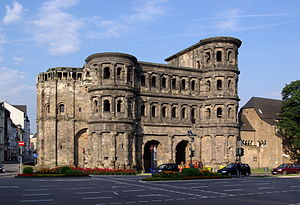
Trier [dead link] on the banks of the Moselle, in the Rhineland-Palatinate region of Germany , is the country's oldest city, dating from Roman times. In 2019, it had 112,000 inhabitants.
Understand [ edit ]
Trier is rich in ruins from the Roman Empire (protected by UNESCO ), such as the Porta Nigra, the Roman baths and Roman amphitheater. As Trier was founded by the Romans as Augusta Treverorum, it can dispute the title of "oldest German city" with Augsburg , Cologne , Kempten and Xanten . Unlike the somewhat provincial and quaint feel the town exudes today, it was actually one of the centers of power during the Imperial Crisis of the 3rd century AD, and certainly the most important Roman town of the province of Germania.
Besides its ample Roman heritage, Trier is also known as the birthplace of Karl Marx, a fact that the city has had difficulty grappling with during more anti-communist times, but now widely markets for tourism.
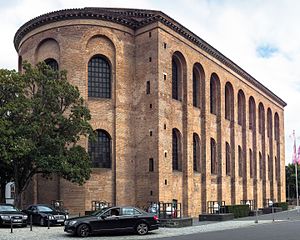
Get in [ edit ]
By plane [ edit ].
There are several airports in the vicinity with reasonable access to Trier.
- Luxembourg Airport ( LUX IATA ) is about 50 km (31 mi) away.
- Low-cost carrier hub "Frankfurt"-Hahn ( HHN IATA ) is 75 km (47 mi) east of Trier. There are roughly-hourly Flibco buses . This airport is also reachable by bus [dead link] from Bullay in 51 minutes, which can be reached using IC trains (34 minutes from Trier Hbf).
- Frankfurt Airport ( FRA IATA ) is about 210 km (130 mi) away. The train from there would be about 3 hours via Saarbrücken or Koblenz .
By train [ edit ]
By car [ edit ].
Trier is connected by the European motorway E44 from Luxembourg city (~50 km) via Trier to Koblenz (~100 km), E422 from Trier to Saarbrücken (~100 km).
Trier is connected to the Autobahn A6. This city is about one hour from Kaiserslautern or two hours from Mannheim .
By boat [ edit ]
There are some cruise trips from Koblenz to Trier. However, they are expensive.
Get around [ edit ]

Walking is the best way to travel around the city, though a vehicle is good when visiting the stadium. Also there is a scenic overview up the hill by the stadium where you can see the entire city. The city tours take you up there.
See [ edit ]

- 49.748305 6.632442 15 old Jewish cemetery ( Jüdische Friedhöfe ), Weidegasse . From the 17th century.
Do [ edit ]

- 49.74756 6.651027 1 Weinkulturpfad . A simple walk over the hill through vineyards, with a few spots explaining the process. Follow the signposted road up the hill next to the amphitheatre, then turn off to walk through the vines and get great views over the valley of Olewig. Take the exit at Olewig and you can stop in to the Blesius Garten. ( updated Sep 2017 )
Learn [ edit ]
Trier hosts a University as well as a University of Applied Sciences (the so-called Fachhochschule ).
The Fachhochschule is in sight of the city. The first buildings were built in 1944 and were used by the Nazis to educate the next generation of soldiers. After the war, the complex was not officially used as a school. In the 1970s the University of Trier was refounded and used the buildings until a new university complex was built on the other side of the Mosel valley. Since then the Fachhochschule uses the complex.
Buy [ edit ]
Eat [ edit ], budget [ edit ].
There are many kebab stores all over the city.
All these are in the city centre:
- 49.753019 6.634443 1 Astarix , Karl-Marx-Straße 11 ( next to the theater, in the south-west of the inner city ), ☏ +49 651 72239 . Inexpensive and tasty meals such as pizza (with your choice of toppings), casseroles, salads etc. can be found in the formerly student-owned pub and restaurant. ( updated Sep 2022 )
- 49.757895 6.640232 2 New Mintons , Jakobstraße 13 ( a few minutes away from the main square ), ☏ +49 651 9790265 . When visiting on a Tuesday be sure to check out ,they have schnitzelabend where you can order any schnitzel with fries and salad for a special price between 18:00 and 22:00. ( updated Sep 2022 )
- 49.753992 6.640504 3 Cubiculum , Hosenstraße 2 . ( updated Sep 2022 )
- 49.757722 6.643723 4 Sieh um Dich , Glockenstraße 8 . ( updated Sep 2022 )
- 49.757816 6.645648 5 Zuppa , Sichelstraße 18 . ( updated Sep 2022 )
- 49.752892 6.638956 6 Derwisch Kebap Haus , Neustraße 93 . ( updated Sep 2022 )
- 49.75781 6.640961 7 Restaurant Aleppo Trier , Stockplatz 1 . ( updated Sep 2022 )
Mid-range [ edit ]
- 49.753504 6.638901 8 Kartoffel Kiste , Fahrstraße 13 , ☏ +49 651 9790066 . German dishes, every way you can serve a potato. ( updated Sep 2022 )
- 49.7647 6.634966 9 Alt Zalawen , Zurlaubener Ufer 79 . ( updated Sep 2022 )
- 49.757774 6.643242 10 früh bis spät , 6-7, Glockenstraße . ( updated Sep 2022 )
Splurge [ edit ]
- 49.743032 6.664859 11 Becker's , Olewiger Straße 206 , ☏ +49 651 938080 . A two-star Michelin restaurant in the Olewig area of Trier. ( updated Sep 2022 )
- 49.75709 6.642324 12 Schlemmereule , Sieh um Dich 1B . ( updated Sep 2022 )
- 49.756779 6.638591 13 Plaza Grill - Restaurant & Lounge , Nikolaus-Koch-Platz 1 . ( updated Sep 2022 )
Drink [ edit ]
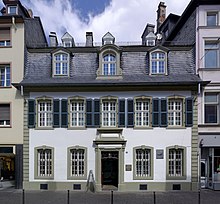
Trier lies at the heart of a famous wine region. In recent decades, vintners have added reds (especially Spätburgunder) and rosés to the traditional whites (especially Riesling). Apart from the standard wines and beers (Trier - Löwenbräu , Cologne - often Gaffel Kölsch , Bitburg - Bitburger ), one should definitely try Viez . Viez is a natural, refreshing apple wine, which many prefer with a splash of orange soda Viez/Limo or with half sparkling mineral water Viez-Sprudel because of the tartness. In October, many enjoy freshly pressed apple juice ( süßen Viez ) or mixing this unfermented juice with half regular Viez. The drink is traditionally served in a white porcelain or stoneware mug holding 0.4 l.
- 49.74337 6.660227 1 Blesius Garten , Olewiger Str. 135 ( in Olewig, a couple of kilometres east of the amphitheatre ). Easy to reach from the amphitheatre, either along the main road or by walking over the hill along over the Weinkulturpfad, this complex has a hotel, a nice beer garden with good food, and, most importantly, their own excellent brewery, Kraft-Bräu. Makes a good change from the Bitburger and a good destination for an afternoon. ( updated Sep 2017 )
- 49.755632 6.642422 2 Weinstube Kesselstatt , Liebfrauenstraße 10 ( opposite the cathedral ). 10:00-00:00 . Great selection of local wines in a nice building with a leafy courtyard opposite the cathedral. Also has light meals like cheese. ( updated Sep 2017 )
- 49.758834 6.633544 3 Zum Petrusbräu , Kalenfelsstraße 3 . 16:00-00:00 . Brewery with some good beers, nice garden, simple meals and a very local vibe. ( updated Sep 2017 )
Nightlife [ edit ]
On www.nightlife-trier.de [dead link] you can find a lot of events in town and Kreis Trier-Saarburg. You can also find some bars on this homepage.
- Metropolis , Hindenburgstraße 4 .
- Musikpark A1 , Über Brücken 4 .
- Club Toni , Domfreihof 1A .
Sleep [ edit ]

- 49.768086 6.640719 1 Youth hostel Trier ( Römerstadt- Jugendherberge Trier ), An der Jugendherberge 4 , ☏ +49 651 146620 . Directly on the banks of the Moselle. about €20/night .
- 49.7419 6.62444 2 Treviris camper parking , In Den Moselauen ( Under Mosel bridge ). Big parking area. Showers, toilet. No power.
- 49.743355 6.659836 3 Blesius Garten , Olewiger Straße 135 , ☏ +49 651-36060 . Very welcoming hotel, based in the Olewig area of Trier, has its own brewery on site. Rooms are well maintained, staff were friendly & helpful. About 2.5 km outside of the city centre. From €100 .
- 49.76101 6.643594 4 Casa Chiara , Engelstraße 8 , ☏ +49 651-270730 . Around the corner from Porta Nigra, this is a solid 3-star hotel with vaguely Italian-style rooms and a sunny roofed garden for breakfast. From €70 .
- 49.757115 6.639635 5 Hotel Frankenturm , Dietrichstraße 3 , ☏ +49 651-978240 , fax : +49 651-9782449 , [email protected] . A boutique hotel in the Old City a block away from the Main Market. Twelve modern and distinctively furnished rooms above a charming restaurant. En suite bath for €20 extra. From €65 .
- 49.77083 6.669985 6 Nells Park , Dasbachstraße 12 , ☏ +49 651 14440 . About 3 km out of Trier, easily accessible by bus, and as the name suggests, within a park. All rooms are individually decorated and in varying states of renovation (ask for a new one). Parking was a bit tight, but plenty of parking on the road next to the hotel. Excellent food too. From €120 .
- 49.759285 6.644874 7 Römischer Kaiser , Porta-Nigra-Platz 6 . Nice modernisation of an old building on the main road, next to the Porta Nigra. Elevator, good staff, champagne breakfast, fancy restaurant, some rooms have views. €100 . ( updated Sep 2017 )
Stay safe [ edit ]
Trier is a relatively safe city. Standard travel safety applies. The railway station can be intimidating at night.
Connect [ edit ]
Go next [ edit ].
- UNESCO World Heritage Sites
- UNESCO tag to be fixed
- Has custom banner
- Articles with dead external links
- Has map markers
- Has mapframe
- Drink listing with no coordinates
- Has Geo parameter
- Moselle Valley (Germany)
- All destination articles
- Usable cities
- Usable articles
- City articles
- Pages with maps
Navigation menu
The Oldest City in Germany – Trier in One Day [2024]
By: Author Corinne Vail
Posted on Published: 13 October 10 - Last updated: 1 January 24
Home » DIY Travel » Germany » The Oldest City in Germany – Trier in One Day [2024]
Wouldn’t you love to visit the oldest city in Germany? After living here for over four years, we’ve got the best places to visit, eat, and sleep.
One summer, on a visit to Germany, we were traveling around our old stomping grounds. We took a boat ride on the Mosel, visited Luxembourg City and the World War II graveyard, and then we arrived in Trier. It felt like coming home. We had lived near the city for four years, and that was the place we went to lunch, to shop, to tour, and just to hang out. We missed it so much.
In this article:
- History of Trier, the oldest city in Germany
- Things to Do and See in Trier
- Trier Attractions Map
- Best Time To Visit Trier
- Getting to and Around Trier
Where is Trier Located?
Trier is located right on the Southwestern border of Germany, next to Luxembourg and France in the state of Rheinland-Palatinate . It’s a great city to base a lot of travel from. Trier is on the Mosel (Moselle) River , and therefore has always been a wine city since the Romans first came. The fantastic wine is just one of the reasons that Trier is worth visiting.
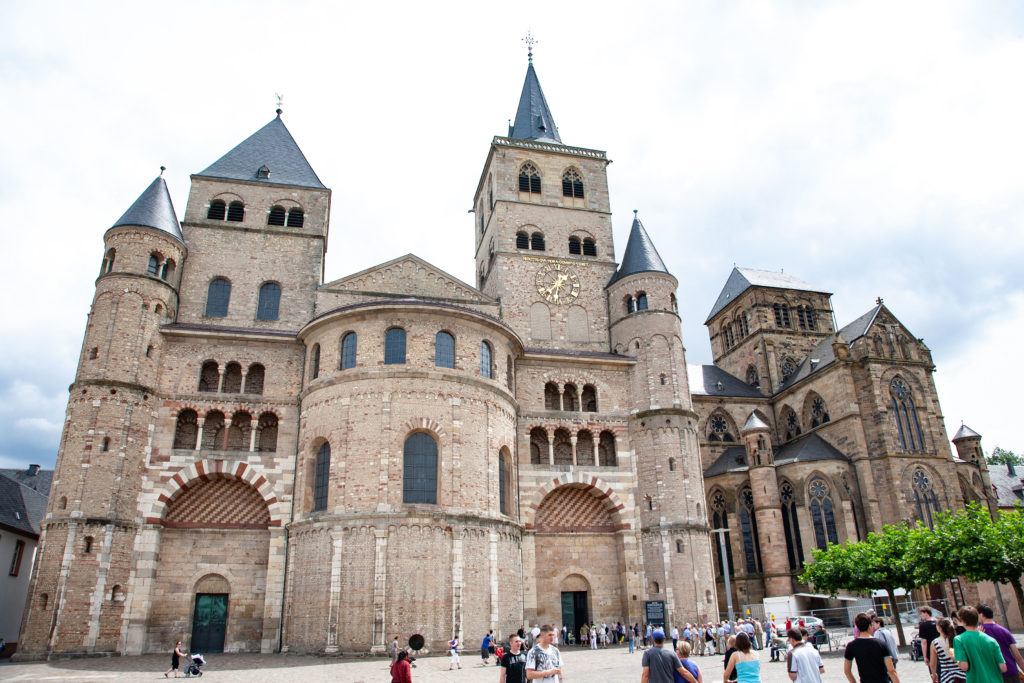
History of Trier
Trier is the oldest city in Germany , and therefore it’s one of the most famous and important cities to put on a travel itinerary. It has been inscribed on the UNESCO World Heritage list for its rich history, and is certainly on our list of world heritage sites in Germany .
The city’s history is recorded back to the Celts in the late 4th century BC and was conquered by the Romans in the 1st century BC ( source ). Called Augusta Treverorum, the city was the western Roman capital for another 400 years. It was also the main city of Christianity in the region and the residence of no less than eight Roman emperors ( source ).
It goes without saying that with this much wealth, Trier became one of the most important trading hubs and economic centers. Because of this, the French wanted the city, and succeeded in capturing it during the years 1794 and 1815. After the Napoleonic wars it became a part of the Prussian Empire and to this day remains German.
Things to See and Do in Trier
Porta nigra, dreikönigenhaus.
- Basilica (Roman)
- St. Peter’s Cathedral
- Karl Marx Haus
- Roman Baths and Amphitheater

Electoral Palace
- Roman Bridge
Rheinisches Landesmuseum
As you walk across the street from the parking garage, the first thing you see is the impressive Porta Nigra , which was one of the four Roman gates protecting the city around 200 AD. It towers over the modern buildings of the city, as it has four stories of large dark stone. I can only imagine that if there were archers and sentries blocking my way, that I would be extremely leery of entering.
As people (read tourists) pass through the gate, they immediately see the Tourist Information center on the right, where you can take tours, ride the tourist train, and a myriad of other activities, and are then smack dab in the Hauptmarkt , the center of the city.
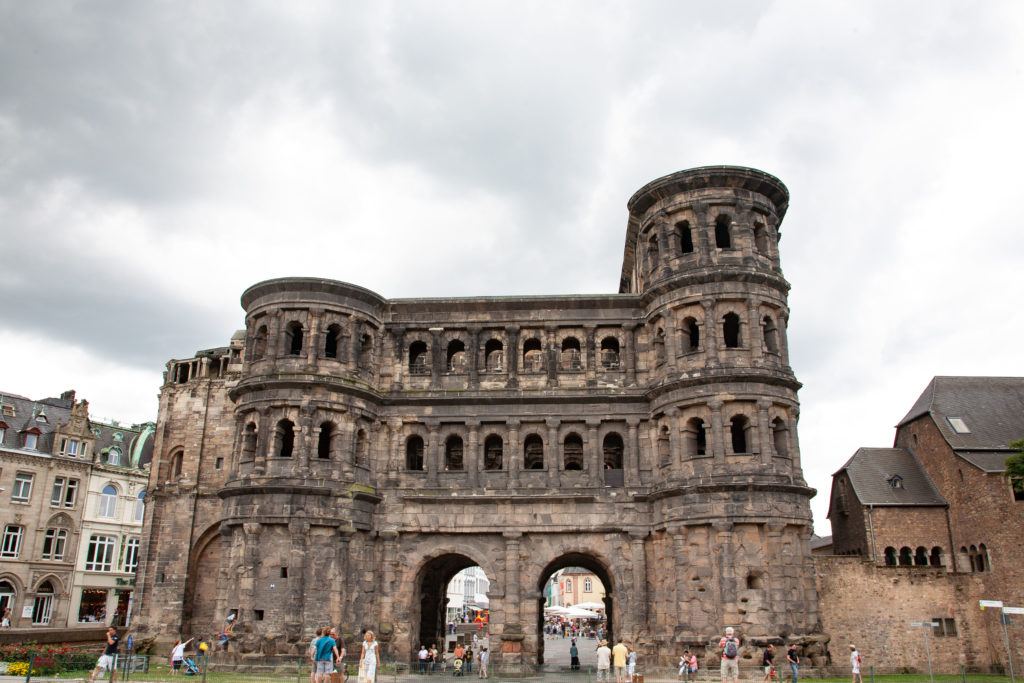
The most iconic sight in Trier, the Porta Nigra was built under Marcus Aurelius’ reign about 170 BC. The imposing gate made of thick stone has many windows for archers and would turn out to be a formidable defense for the city.
After the fall of the Romans, and with no need for a gate, a small chapel dedicated to St. Simeon was built on one of the floors which is why it was never destroyed. Parts have been rebuilt out of materials found at the time of renovation, so in some places you can pick out the materials, like bricks or a red stone which is found not far from Trier ( source ).
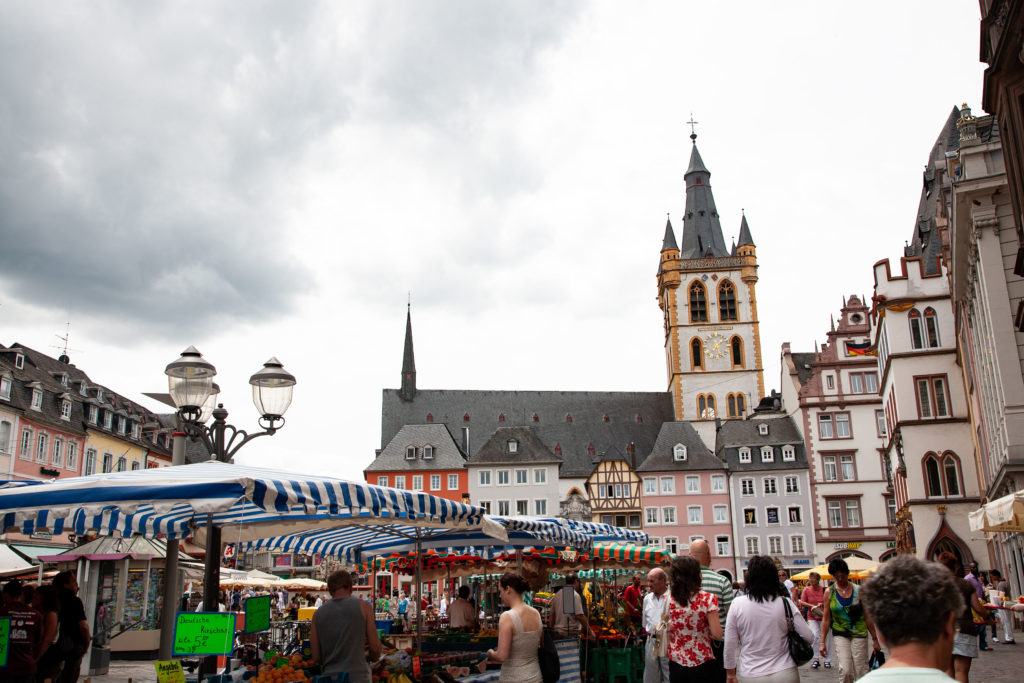
Trier’s market area is one of my favorite places. I love wandering the square, gawking at half-timbered houses, stopping off at a konditoriei or café for a quick snack, and continuing to sightsee. The Hauptmarkt hosts a weekly Saturday market full of local vendors selling fresh, in-season produce, as well as a small but charming Christmas Market each year.
Other Germany Christmas articles:
- Top 5 Bavarian Christmas Markets Itinerary
- 7 Tips for Winning German Christmas Markets with Kids!
- Dresden Christmas Stollen and Parade
- Krampus Nights in Germany
The Dreikönigenhaus or House of the Three Magi, is right in the middle of the market square. I remember the very first time I visited, and was shown the only entrance to this building on the second floor. Right away, it made Trier a magical place for me.
Explaining that the city was very dangerous during much of its history, the entrance was only accessible by a ladder that you could pull in when it wasn’t in use. Today the building is brightly painted with statues hung on the exterior. On the ground floor you’ll find a café to sit and watch the goings-on in the Hauptmarkt.
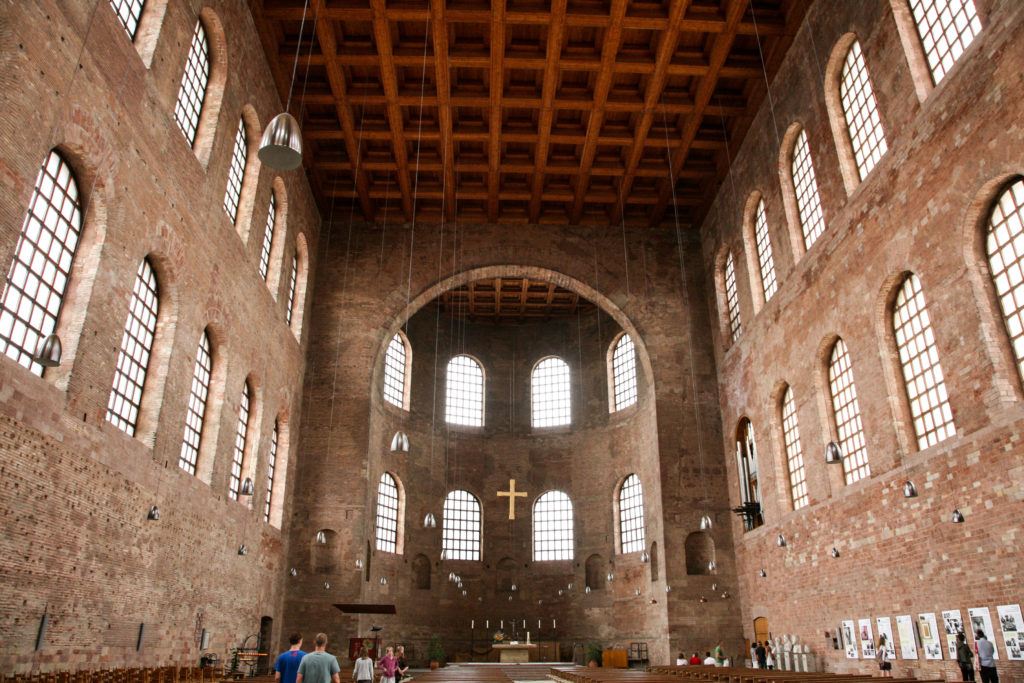
Home to Constantine the Great, Augusta Treverorum (Roman name of Trier at the time) built the Basilica. It is known by a couple of names, Constantine’s Basilica or Aula Palatina. The emperor entertained audiences there, and after the Romans left it became a church ( source ).
Today, if you walk in, you will notice a distinct lack of decoration. The walls are quite high, luckily with windows, but there is not much to depict it as a religious building except maybe the rows of pews. Part of the world heritage designation, the Basilica is also known for it being the largest surviving building from Roman times.
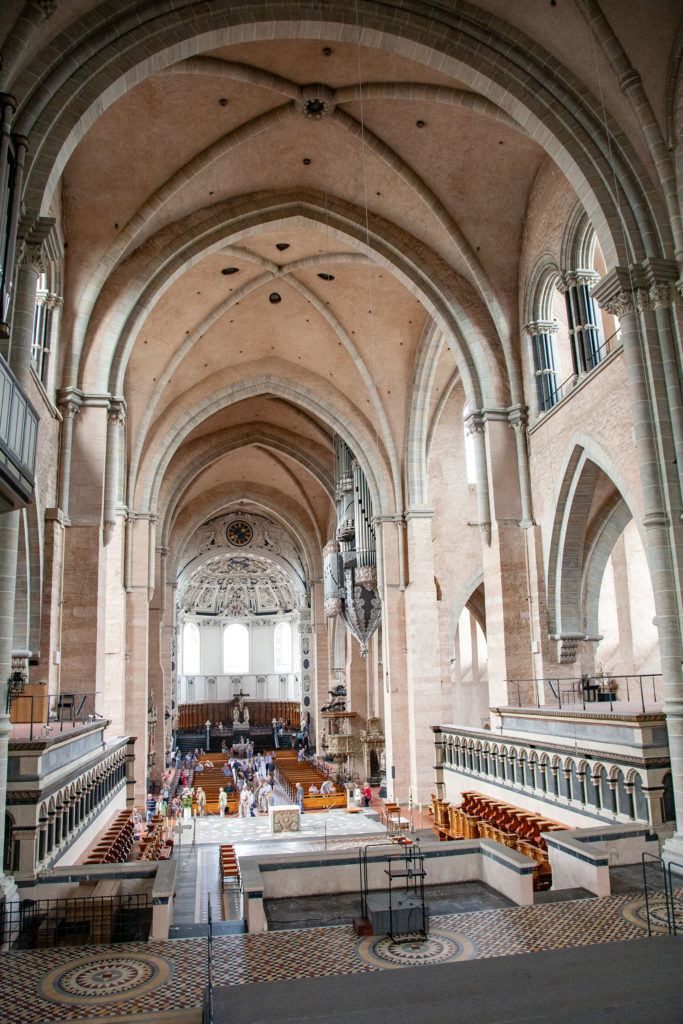
St. Peter’s Cathedral (Dom)
The cathedral was originally commissioned by Constantine himself in 326 AD and is considered the oldest in Germany. Just like many other cathedrals, there are plenty of paintings, sculptures, crypts, and such. The one thing that this cathedral has that others haven’t is the robe of Christ.
Reportedly it came directly from Jerusalem via Constantine’s mother who made many pilgrimages to the holy city. This is the seamless robe that Jesus was supposed to be wearing during his crucifixion. Needless to say, it’s a very important relic, and pilgrims come from all over the world to see the room that it is kept in. The robe is shown on occasion, but I haven’t seen it.
Karl Marx House
The founder of modern communism, Karl Marx, was born in Trier in 1818, one of the facts that makes it a famous destination. The house where he was born is now a museum telling about his life and the book he wrote that changed many parts of the world, “Das Captital.”
His house is very near the Hauptmarkt, but you have to wind your way in the back part of it to find it. It’s located at Brückengasse #10. The museum is well put together with some interactive displays. You will definitely leave with a better understanding of his ideas.
Roman Baths and Ampitheater
These two spots are truly ruins. The baths are a tall brick structure where you can wander around. In Roman times it was a huge complex housing the baths and the work out rooms. The amphitheater is not much more than a grassy circle. However, it’s great for playing with kids and explaining to them what once took place there. Neither of these sites will take you more than just a few minutes, but they are integral parts of the reason that Trier is such a famous place to visit as they are part of the world heritage.
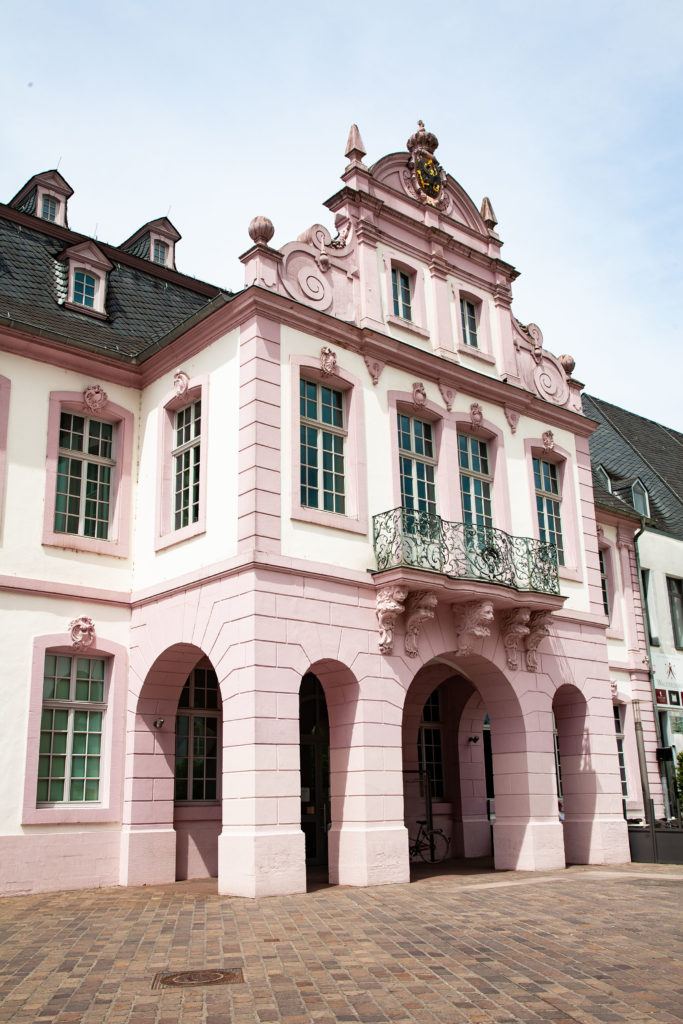
This pink rococo palace built for Emperor Constantine is a beauty. The Electoral Palace building is still used by the government, so touring the amazing interior is only open on specific days, so check the website or call before going. However, even if you can’t go inside, the palace exterior and gardens are spectacular so make sure to wander that way.
Roman Bridge (Römerbrücke)
According to the Trier Tourism website, the Roman bridge as it is now was first built upon a wooden bridge in the year 144, and for the last 1900 years has been used continuously. A beautiful site, there’s plenty to do down by the river.
If you are only going to visit one museum in Trier, make it the Rheinisches Landesmuseum . Even though the walking circuit takes you through 200,000 years of history, the main portion is all about the Romans in the area. The artifacts are impressive, and the most impressive is the “Trier Gold Horde,” these coins make up the largest Roman horde in the world.
Read our most popular articles on Germany! – Winter in Germany – Bavarian Christmas Markets ( + Itinerary) – Variations of Schnitzel – 5 Things You Didn’t Know about the Hofbrauhaus (Munich) – Fairytale Rothenburg and its Christmas Market
Trier Walking Map
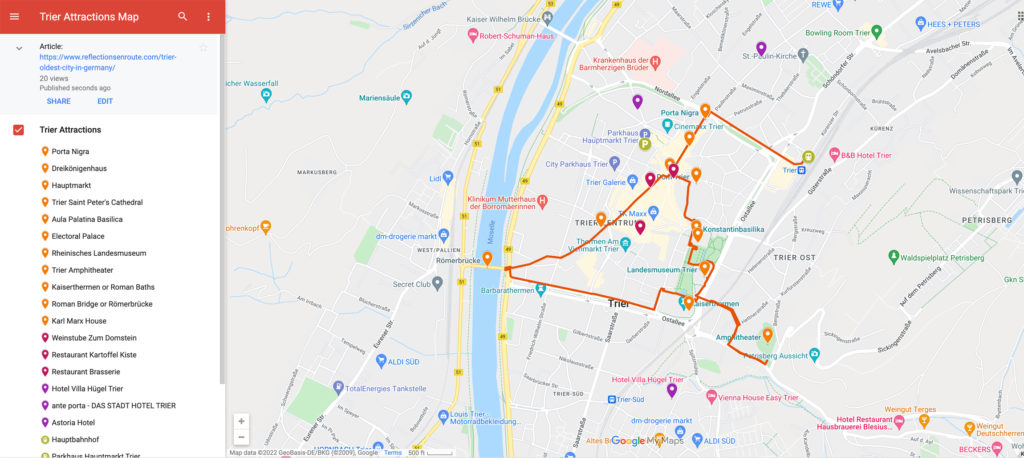
Best Time to Visit Trier
Trier has typical German weather. During the majority of the year, it can be damp and chilly. Only in the summer does the weather get pretty warm, but June is still part of the rainy period. For the best chance at having a warm and dry day, the three best months to visit are July, August, and September.
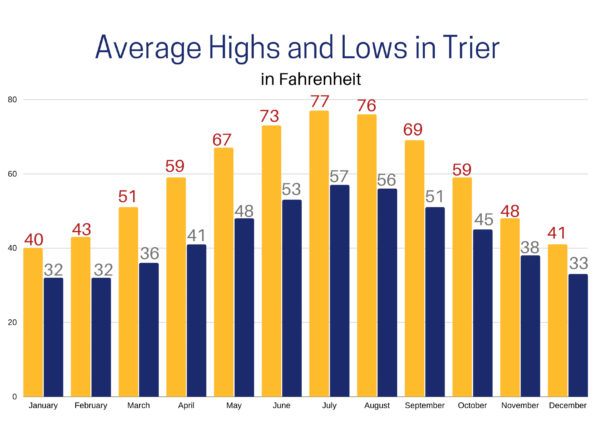
Getting To and Around Trier
If you are traveling around Germany, you may have flown into Frankfurt or another city. Trier is about a 2.25 hour drive from the Frankfurt Airport by car and no less than 3 hours by train. However, a closer airport is the one in Luxembourg.
Luxembourg City is only a 30 minute drive and I’ve found sometimes you can get better deals flying into that airport, since even though it’s an international airport, it’s very small. ANother option is Frankfurt Hah with flughts by Ryan Air. You can take a flibco shuttle bus from Hahn to Trier Hauptbahnhof.
Once in Trier, if you are arriving on foot, you will be happy to note that it’s a very walkable city. The Hauptbahnhof is only a 12 minute walk, so basically everything is right there. If you decide to venture further, the bus system goes everywhere and is very inexpensive and easy to use.
Where to Eat
As you can imagine, there are plenty of great restaurants and cafés in and around the Hauptmarkt and really throughout the city. I highly recommend trying some of the typical German dishes , but you can also find plenty of Asian and Italian places as well.
One favorite is the Domstein Restaurant located next to the Basilica. It not only serves great modern German food, but it also is known for having some ancient Roman recipes on the menu as well.
Kartoffel Kiste
If you love potatoes, this restaurant on the pedestrian zone is perfect for you. Kartoffel Kiste celebrates the tuber in so many ways, from potato bread to potato soup, fried, baked, boiled, and any way you can imagine. It’s great for vegetarians (although there are plenty of meat options) and children too.
Brasserie Trier
To be honest, the reason I love Brasserie Trier is it serves the best beer. My favorite beer in Germany is Bitburger Pils which is brewed up the road a few miles It’s a bitter pils and goes so well with pork and beef.
Things to Do Nearby Trier
- Mosel River Boat Cruise
- Luxembourg City (about 40 minutes by car)
- Metz, France (a little over 1 hour by car)
- Frankfurt (about 2 hours by car)
Resources -Trier Trier Tourismus and Marketing
As you can see, there is plenty to do in Germany’s oldest city . No matter what, the Porta Nigra alone is worth the trip. Hosting the best Roman sights in the country, and nestled between lots of Mosel River vineyards, it’s a great place to really enjoy some German culture.
Author Bio: Corinne Vail is a travel photographer, food lover, and a perpetual traveler who has been travel writing for over 14 years. For many years she lived overseas in Germany, Japan, Turkey, South Korea, and the Netherlands teaching the children of the US. military. She’s visited over 90 countries, and she’s not stopping anytime soon.
If you loved Trier...
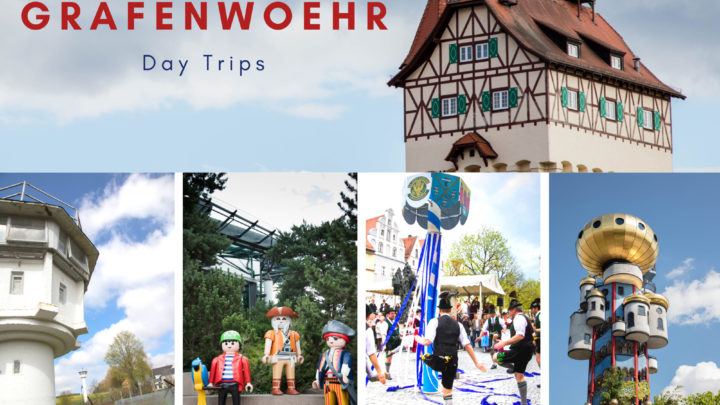
15+ Best Day Trips from Grafenwoehr and Vilseck
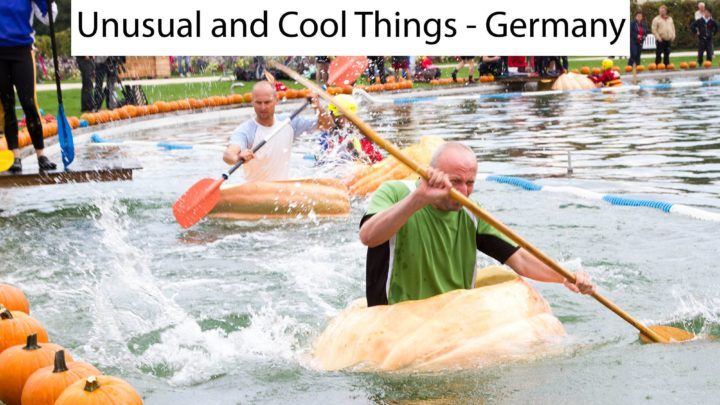
Top 10 Unusual and Cool Things You Can Do Only in Germany
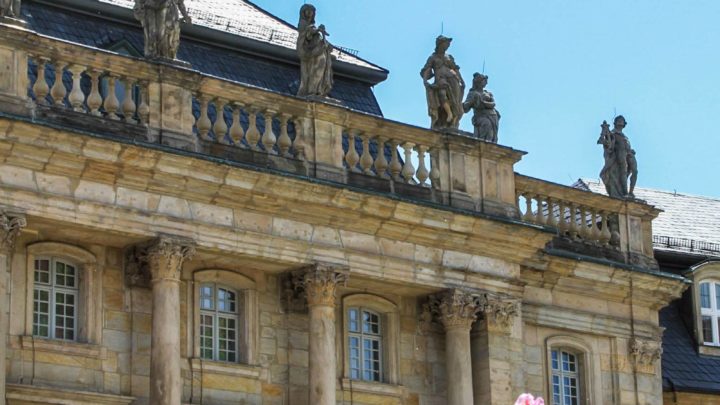
Germany Travel Blog
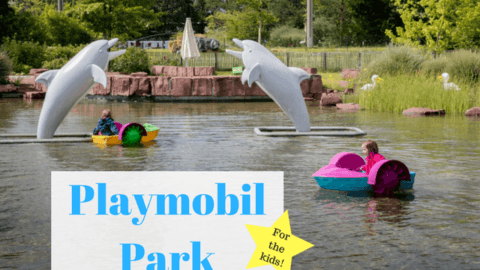
Playmobil FunPark in Germany - Fun for All Ages
Gliding across lake königssee, germany.
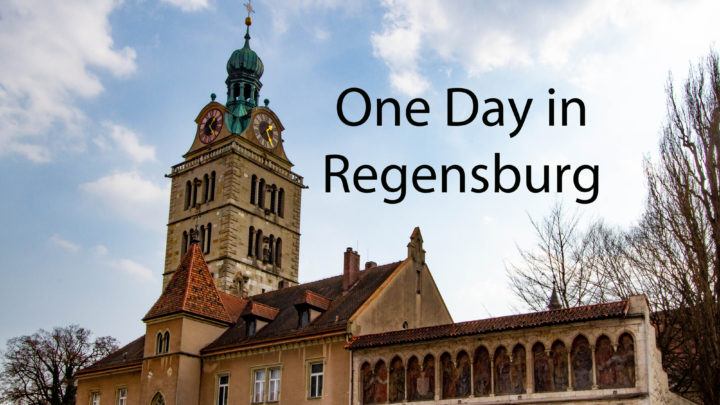
One Perfect Day in Regensburg, Germany
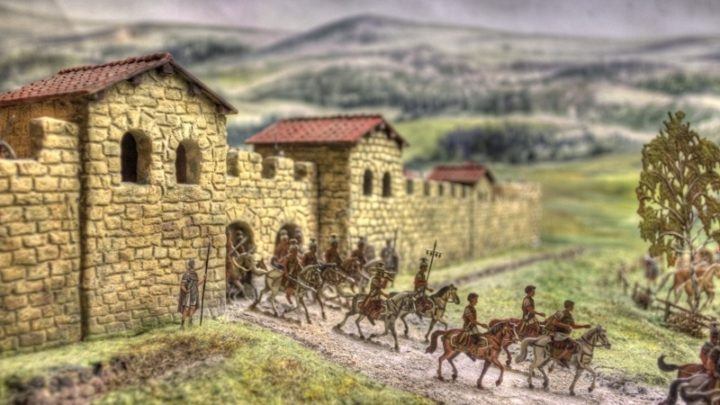
Frontiers of the Roman Empire in Germany - The Limes Unesco World Heritage Site
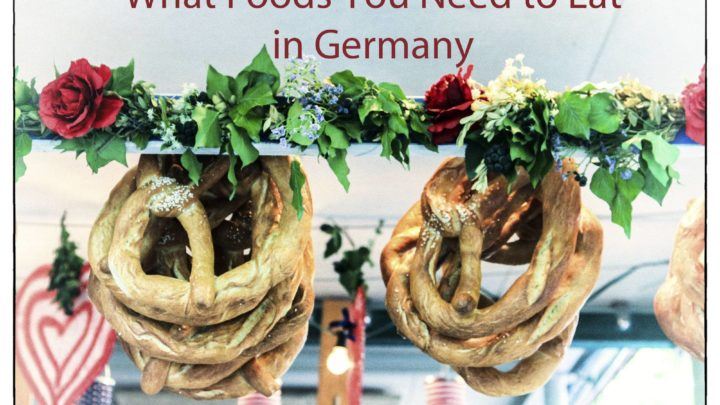
The Top 5 Best Foods You Must Eat in Germany
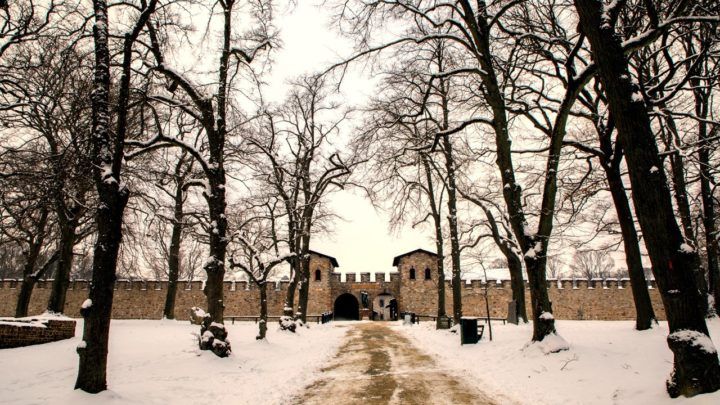
Saalburg Roman Fort and Museum - Only 30 Minutes from Frankfurt
Things to do on a long layover in frankfurt (fra).
- 11 Reasons To Visit Trier...
Reasons to Visit Trier, Germany at Least Once in Your Lifetime

Despite the fact that Trier is one of Germany ’s oldest cities and boasts an impressive eight UNESCO World Heritage Sites , this small city in the west of the country is often overlooked by international tourists. We think that should change – here’s a list of 11 reasons to visit Trier at least once in your lifetime.
Did you know – Culture Trip now does bookable, small-group trips? Pick from authentic, immersive Epic Trips , compact and action-packed Mini Trips and sparkling, expansive Sailing Trips .
It’s the Rome of the north
After the arrival of the Romans around 17 BC and the establishment of a permanent city, Trier quickly developed to become a Roman metropolis. The large number of well-preserved Roman monuments here is unparalleled north of the Alps, and has earned Trier the nickname ‘Rome of the north’. The ancient remnants can be visited today, including the majestic Porta Nigra gate.

A tour of Trier will take you past a whopping eight UNESCO World Heritage Sites – the above-mentioned Roman sites all have UNESCO World Heritage status. As well as the Porta Nigra gate, Constantine’s throne room, the imperial bathhouses, the Roman bridge and an amphitheatre are scattered across the city. But that’s not i – Trier is also known for its cathedral and 13th-century Church of Our Lady (Liebfrauenkirche), Germany’s oldest Gothic church.
The medieval town centre has to be seen to be believed

The city core centres around Hauptmarkt, the city’s largest market square. The plaza is encircled by well-preserved townhouses that create a mixed cityscape of Renaissance, Baroque, Classicist and late Historicist architecture overlooked by the tower of St. Gangolf’s church. The red 15th-century Steipe building is another eyecatcher in this colourful mix.
It’s Karl Marx’s birthplace
In 1818 the communist revolutionary Karl Marx was born in Trier. His birthplace still stands in Brückengasse 10 and has been converted into a museum that depicts his early life in Germany, his ground-breaking concepts and their influence on the course of history until now and his time in exile in London where he passed away at the age of 64.
The cathedral is the oldest in Germany

Trier Cathedral alone is enough of a reason to visit. With more than 1,700 years of history under its belt, it’s the oldest in the country. The architectural mix of Gothic, Baroque and Romanesque elements attest to the cathedral’s long history, but the treasury is also worth a visit. It displays a remarkable collection of religious art dating back to late antiquity.
You can lunch in Luxembourg
Trier is a mere 15 kilometres (9.3 miles) from the Luxembourg border and an obvious choice if you fancy a side trip to another European country. A 50-minute train ride takes you to Luxembourg City which boasts a grand palace, beautiful churches and historical monuments that will easily fill a day of sightseeing. Sweeten the trip with a slice of the traditional quetschentaart (plum tart) and if that’s not enough, make sure to stock up on some pastries at Oberweis before you head back.
There are romantic river views
Spread across both sides of the Mosel river, Trier has some stunning waterfront vistas, but it’s worth taking a mini cruise to venture beyond the city borders. Medieval towns, castle ruins and picturesque vineyards dominate the region and hold endless possibilities to explore some German off-the-beaten-track destinations.
Wining and dining is a delight
The Mosel river doesn’t just provide Trier with scenic views, but also with some of the best white wines you’ll find in Germany. The steep hills of the valley are clad with terraced vineyards which mostly cultivate Riesling grapes. A trip to Trier is not complete a pairing of award-winning white wines and regional culinary specialities. One of the top addresses for wine tastings in the city centre is Weinstube Kesselstatt .
It’s home to the House of the Three Magi
If you stroll down Simeonstrasse, one building is sure to catch your eye. Built around 1230, even before the construction of Trier’s medieval city wall was completed, the House of the Three Magi (Dreikoenigenhaus) was already occupied by a wealthy and probably influential family. Back then, the main entrance to the house was located on the first floor and could only be reached by a ladder that could be pulled up to prevent unwelcome guests from entering.
The former Jewish quarter is fascinating
Traces of a Jewish community in Trier date back to antiquity and can be visited today. Guided tours take you to historic sites, such as a former bathhouse and the half-timbered houses of Jew’s Alley (Judengasse) which once marked the centre of the community. In 1418, the Jewish community was expelled from the city and only called back in 1600, after which families then spread out across the city.
There are plenty of picturesque hiking trails
Outdoor fans should explore the hiking trails that traverse the region around Trier. The three major paths run by the names Saar-Hunsrück-Steig, Eifelsteig and Moselsteig and cover the highlights of panoramic valley views, forested areas, romantic streams and cultural sights. Most routes start at the tourist information centre.
Since you are here, we would like to share our vision for the future of travel - and the direction Culture Trip is moving in.
Culture Trip launched in 2011 with a simple yet passionate mission: to inspire people to go beyond their boundaries and experience what makes a place, its people and its culture special and meaningful — and this is still in our DNA today. We are proud that, for more than a decade, millions like you have trusted our award-winning recommendations by people who deeply understand what makes certain places and communities so special.
Increasingly we believe the world needs more meaningful, real-life connections between curious travellers keen to explore the world in a more responsible way. That is why we have intensively curated a collection of premium small-group trips as an invitation to meet and connect with new, like-minded people for once-in-a-lifetime experiences in three categories: Culture Trips, Rail Trips and Private Trips. Our Trips are suitable for both solo travelers, couples and friends who want to explore the world together.
Culture Trips are deeply immersive 5 to 16 days itineraries, that combine authentic local experiences, exciting activities and 4-5* accommodation to look forward to at the end of each day. Our Rail Trips are our most planet-friendly itineraries that invite you to take the scenic route, relax whilst getting under the skin of a destination. Our Private Trips are fully tailored itineraries, curated by our Travel Experts specifically for you, your friends or your family.
We know that many of you worry about the environmental impact of travel and are looking for ways of expanding horizons in ways that do minimal harm - and may even bring benefits. We are committed to go as far as possible in curating our trips with care for the planet. That is why all of our trips are flightless in destination, fully carbon offset - and we have ambitious plans to be net zero in the very near future.

Places to Stay
The best hotels to book in trier, germany, culture trip spring sale, save up to $1,100 on our unique small-group trips limited spots..

- Post ID: 1703004
- Sponsored? No
- View Payload
- Zur Kopfnavigation springen
- Zur 1. Ebene der Hauptnavigation springen
- Zum Hauptinhalt springen

- Bilderservice
- Allgemeine Infos
- Plattform X
- Bekanntmachungen
- Vergabeverfahren
- Interessenbekundung
- Digitale Vergabe
- Vergebene Aufträge
Dienstleistungen A-Z
Onlinedienste.
- Datenschutzhinweise
- Einzugsermächtigung
- SEPA-Informationen
- Beherbergungsteuer
- Hundesteuer
- Vergnügungssteuer
- Zweitwohnungsteuer
- Terminvereinbarung
- Öffentliche Zustellungen
- Dezernat II
- Dezernat III
- Dezernat IV
- Bürgeramt am Viehmarkt
- FAQ Corporate Design
- Was ist was?
- Entschuldungsfonds
- Reden der Ratsfraktionen
- Das Amt des OB
- Ziele - Reden - Positionen
- Mayors for Peace
- Mayors United Against Antisemitism
- Städte für das Leben
- Besuche und Besucher
- Stadtvorstand
- Ausbildungsberufe
- Freiwilliges Soziales Jahr
- Bundesfreiwilligendienst
- Nebenamtliche Lehrbeauftragte
- Arbeitgeberin Stadt
- Nutzungsbedingungen Onlinebewerbung
- Fraktion Bündnis 90/Die Grünen
- CDU-Fraktion
- SPD-Fraktion
- AfD-Fraktion
- Linksfraktion
- UBT-Fraktion
- FDP-Fraktion
- Fraktion Die FRAKTION
- Ratsinformationssystem
- Video und Audio
- Plattform für Bürgerbeteiligung
- Ideen & Beschwerden
- Fragestunde für Einwohner/innen
- Ortsbeiräte
- Beirat für Migration und Integration
- Beirat für Menschen mit Behinderung
- Jugendparlament
- Seniorenbeirat
- Europa- und Kommunalwahl 2024
- Wahlhelfer/in werden
- Zukunft Trier
- Städtepartnerschaft aktuell
- Ascoli Piceno, Italien
- Metz, Frankreich
- Pula, Kroatien
- 's-Hertogenbosch, Niederlande
- Gloucester, Großbritannien
- Fort Worth, USA
- Weimar, Deutschland
- Nagaoka, Japan
- Xiamen, China
- QuattroPole
- Landschaftsnetz Mosel
- Modellvorhaben Regiopolen
- Stadt-Fokus
- Informationsblätter
- Wichtige Adressen
- Trier im Video
- Ortsvorsteher/Ortsbeirat
- Leben in Mitte-Gartenfeld
- Mitte-Gartenfeld aktuell
- Veranstaltungen
- Biewer aktuell
- Leben in Biewer
- Ehrang/Quint aktuell
- Leben in Ehrang/Quint
- Impressionen
- Euren aktuell
- Leben in Euren
- Feyen/Weismark aktuell
- Leben in Feyen/Weismark
- Filsch aktuell
- Leben in Filsch
- Heiligkreuz aktuell
- Leben in Heiligkreuz
- Irsch aktuell
- Leben in Irsch
- Kernscheid aktuell
- Leben in Kernscheid
- Kürenz aktuell
- Leben in Kürenz
- Mariahof aktuell
- Leben in Mariahof
- Trier-Nord aktuell
- Leben in Trier-Nord
- Ortsvorsteherin/Ortsbeirat
- Olewig aktuell
- Leben in Olewig
- Pfalzel aktuell
- Leben in Pfalzel
- Ruwer/Eitelsbach aktuell
- Leben in Ruwer/Eitelsbach
- Trier-Süd aktuell
- Leben in Trier-Süd
- Tarforst aktuell
- Leben in Tarforst
- Trier-West/Pallien aktuell
- Leben in Trier-West/Pallien
- Zewen aktuell
- Leben in Zewen
- Gesundheitsamt
- Gesundheitsförderung
- Hilfetelefone
- Komm. Vollzugsdienst
- Anliegerpflichten
- Fragen und Antworten
- Live-Ticker
- Hilfsangebote für Flutopfer
- Bildergalerie
- Heizölanlagen
- Meldedienste
- Bin ich gefährdet?
- Historische Hochwasser
- Frauenbeauftragte
- Istanbul-Konvention
- Fair-Trade-Stadt
- Gleichgeschlechtliche Ehe
- Städtische Kitas
- Elternbeiträge
- Vermittlung von Kindertagespflege
- Kindertagespflegeperson werden
- Spiel- und Bolzplatzkatalog
- Temporäre Spielstraßen
- Trier für Kinder
- Soziale Gruppenarbeit
- Erziehungsbeistandschaft
- Sozialpädagogische Familienhilfe
- Tagesgruppe
- Stationäre Hilfen
- Lernförderung
- Schulausflüge und Klassenfahrten
- Schulbedarf
- Schülerbeförderungskosten
- Zuschuss zum Mittagessen
- Soziale und kulturelle Teilhabe
- Beratungsdienst Trennung und Scheidung
- Schwangerenberatung
- Pflegekindervermittlung und -betreuung
- Jugendgerichtshilfe
- Hilfen bei sexuellem Missbrauch
- Hilfe für junge Volljährige
- Schutz von Kindern und Jugendlichen
- Inobhutnahme
- Jugendkonferenz
- Eigener Jugendraum
- Mergener Hof
- Ehrang/Quint
- Weidengraben
- Legale Graffiti-Flächen
- Seniorenbüro
- Vertrauenspersonen
- Artikel und Berichte
- Aktionsplan Inklusion
- Special Olympics 2023
- Welche Informationen stehen auf unserer Internet-Seite (LS)
- Wie funktioniert diese Internet-Seite (LS)
- Barriere-Freiheit von dieser Internet-Seite (LS)
- Solidarkarte (LS)
- Ober-Bürgermeister (LS)
- Menschen mit Behinderungen
- Flüchtlinge
- Sicherer Hafen
- Einbürgerung
- Neu in Trier
- Lebens(t)raum Innenstadt Trier
- Lebendiges Zentrum
- Klimaraum Trier
- Innenstadt-Impulse
- Soziale Planung
- Hilfe zum Lebensunterhalt
- Grundsicherung
- Eingliederungshilfe
- Hilfe zur Pflege
- Bestattungskosten
- Friedhof Biewer
- Friedhof Ehrang
- Friedhof Eitelsbach
- Friedhof Euren
- Friedhof Filsch
- Friedhof Kernscheid
- Friedhof Olewig
- Friedhof Pallien
- Friedhof Pfalzel
- Friedhof Quint
- Friedhof Ruwer
- Friedhof Tarforst
- Friedhof Zewen
- Hauptfriedhof
- Höhenfriedhof
- Südfriedhof
- Westfriedhof
- Die Gründung der Stadt
- Triers erste Glanzzeit
- Residenz des weströmischen Reichs
- Trier im Früh- und Hochmittelalter
- Freie Reichsstadt Trier?
- Trier in der Frühen Neuzeit
- Trier in Frankreich und Preußen
- Weltkriege und Nationalsozialismus
- Trier in Europa
- Literatur zur Stadtgeschichte
- Jahresrückblick 2021
- Jahresrückblick 2020
- Jahresrückblick 2019
- Jahresrückblick 2018
- Jahresrückblick 2017
- Jahresrückblick 2016
- Jahresrückblick 2015
- Jahresrückblick 2014
- Jahresrückblick 2013
- Jahresrückblick 2012
- Jahresrückblick 2011
- Jahresrückblick 2010
- Jahresrückblick 2009
- Jahresrückblick 2008
- Jahresrückblick 2007
- Jahresrückblick 2006
- Jahresrückblick 2005
- Jahresrückblick 2004
- Jahresrückblick 2003
- Kaiserin Helena
- Konstantin der Große
- Ambrosius von Mailand
- Simeon aus Syrakus
- Balduin von Luxemburg
- Caspar Olevian
- Friedrich Spee
- Clara Viebig
- Oswald von Nell-Breuning
- Oberbürgermeister von 1815 bis heute
- Weltkulturerbe
- Balduinbrunnen
- Grillen im Park
- Historischer Steckbrief
- Initiative Renaissance Nells Park
- Initiativen
- Mobile Hochbeete
- Rathausbienen
- Kleingärten
- Partnerschaftsgärten
- Weißhauswald
- Eichenprozessionsspinner
- Junge Stadt
- Heute in Trier
- Karl-Berg-Musikschule
- Porta hoch drei
- Kulturfrühling
- Trier für Treverer
- Trierer Rede
- Veranstaltung planen
- Kulturszene aktuell
- Kulturspektrum
- Kulturprogramm Landesausstellung 2025
- Grenzüberschreitende Kulturförderung
- Mottoförderung
- Kulturleitbild
- Kunstakademie
- Ausstellungen
- Ehrenamtliches Engagement
- Lebenslauf Nell-Breuning
- Paul Kirchhof
- Helmut Schmidt
- Der Päpstliche Rat Cor Unum
- Erzbischof Paul Josef Cordes
- Bernhard Vogel
- Hans-Jochen Vogel
- Norbert Blüm
- TransFair e.V.
- Heiner Geißler
- Franz Müntefering
- Heinrich Bedford-Strohm
- Vergünstigungen
- Bewegungsparcours
- Freibad Nord
- Freibad Süd
- Übersicht Schwimmbäder
- Moselstadion
- Theatersanierung
- Freunde und Förderer
- Jazz-Rock-Pop
- Klassische und Sakrale Musik
- Musikvereine
- Sonstige Kulturvereine
- Sportvereine
- Selbsthilfe
- Wirtschaft aktuell
- Gemeinde Europas
- Mobilfunkstandard 5G
- Zahlen & Fakten
- Branchenführer
- Euren-Zewen-Monaise
- Seidel-Kaserne
- Vermietung gewerblicher Objekte
- Gewerbliche Mieten
- Ansprechpartner
- Qualitätssiegel
- Veranstaltungen & Termine
- Netzwerk-Mitglieder
- Mitarbeit im Netzwerk
- Finanzhilfen für Unternehmen
- Ukraine-Infos für Unternehmen
- Wochenmärkte
- Verkaufsoffene Sonntage
- Werbesatzung
- Einzelhandelskonzept
- Messepark Trier
- Arena Trier
- Dual Studieren in Trier
- Jobberatung
- Job- und Karrieremessen
- Stellenbörsen
- Fachkräftegewinnung
- Weiterbildung
- Familie und Beruf
- Existenzgründung
- Veranstaltungskalender
- Healthcare Hackathon
- QuattroPole Health Hackathon
- Präsentation Masterplan / Unternehmensbefragung
- Beratungsangebote
- Grundschule
- Überblick Förderschulen
- Privatschule St. Josef
- Medardschule
- Porta-Nigra-Schule
- Treverer-Schule
- Wilhelm-Hubert-Cüppers-Schule
- Blandine-Merten-Realschule
- Kurfürst-Balduin-Realschule plus
- Nelson-Mandela-Realschule plus
- Moseltal Realschule plus
- St. Maximin-Schule
- Montessori-Schule
- Integrierte Gesamtschule
- Waldorfschule
- Montessorischule
- Berufsvorbereitungsjahr
- Berufsschule
- Berufsfachschule
- Berufsoberschule
- Berufliches Gymnasium
- Berufsbildende Schulen in Trier
- Einschulung und Anmeldeverfahren
- Übergang Grundschule-weiterführende Schule
- Betreuende Grundschule
- Schulbuchausleihe
Schülerbeförderung
- Ausbildungsberufe Stadt Trier
- Berufsbildende Schulen
- Förderungen
- Auftrag des KBM
- Trierer Schulwegweiser
- Trierer Lupe
- Datenbank Bildungsberatung
- Der Bildungsgutschein - Beratungsstelle
- MINT-Region Trier
- Haus der kleinen Forscher
- Trierer Bildungswerkstatt
- MINT Digitalisierung
- MINT-Initiativkreis
- Trierer Bündnis für Alphabetisierung und Grundbildung
- Aufgaben und Projekte
- Datenbank TILL
- Knotenpunkte
- Diesterweg-Stipendium
- Inhalte und Ziele
- Volkshochschule
- Weiterbildung im Sport
- Sprachen lernen
- Bibliotheken / Archive
- Unterm Knieberg
- Vergaberichtlinien
- Castelnau-Mattheis
- Burgunderviertel
- Baulandkataster
- Innenentwicklungskonzepte
- Baulandumlegung
- Umlegungsausschuss
- Wohnung Mariahof
- Jägerkaserne
- Stellplatzvermietung
- Tätigkeiten
- Produkte und Preise
- Auszüge + Auskünfte
- Grundstücksmarktbericht
- Barrierefreiheit
- Nagelplattenbauweise
- Mietspiegel
- Wohnbauprojekt Hofgut Mariahof
- Wohnbauprojekt Filsch BU 14
- Wohnberechtigungsscheine
- Wohnraumförderung
- Wohnungsberatung
- Kita und Grundschule Feyen
- Halle am Mäusheckerweg
- Bezirkssportanlage West
- Bezirkssportanlage Feyen
- Denkmalpflegebeirat
- Denkmalzone
- Grabungsschutzgebiet
- Kulturdenkmäler
- Unterschutzstellungen - Denkmalliste
- Steuererleichterungen
- Aktuelle Verfahren
- Archiv Bauleitplanung
- Rechtsverbindliche Bebauungspläne
- Flächennutzungsplan
- Tarforster Höhe
- Erhaltungssatzungen
- Gestaltungssatzungen
- Lichtmasterplan
- Sanierungsgebiete
- Verkehrswege
- Tag der Städtebauförderung
- Umfeld Römerbrücke
- Umfeld Porta Nigra
- Aufwertung Moselufer Trier-Nord
- Ausgleichsmaßnahme "Monaise"
- Stadtteilrahmenpläne
- Öffentliche Toiletten
- Workshop Post- und Bahnhofsbereich
- Tiny Houses
- Geoportal (en)
- Géoportail (fr)
- Nutzungsbedingungen
- Geoportal 3D
- Stadtgrundkarte
- Straßennamen / Hausnummerierung
- Architektur- und Städtebaubeirat
- Klimaschutz aktuell
- Energiebericht
- Energiebedarf & CO2-Ausstoß
- Klimaschutzmanagement
- Klimanotstand
- Energiequartier
- Solardachkataster
- Energiesparen
- Klimawandelanpassung
- Photovoltaik
- Wärmeplanung
- Stickstoffdioxid
- Schwefeldioxid
- Grenzwertüberschreitung
- Bilanz 2022
- Lärmkartierung 1. Stufe
- Lärmaktionsplan 1. Stufe
- Lärmkartierung 2. Stufe
- Lärmaktionsplan 2. Stufe
- Pilotprojekt Tempo 30
- Schornsteinfegerwesen
- Mattheiser Wald
- Kenner Flur
- Gillenbachtal
- Kiesgrube Oberkirch
- Natura 2000
- Landschaftsplanung
- Zulässigkeiten, Folgen, Kompensation
- Verfahren bei Eingriffen
- Fachbeitrag Naturschutz
- Allgemeiner Artenschutz
- Besonderer Artenschutz
- Washingtoner Arten- schutzübereinkommen
- Artenschutz auf lokaler Ebene
- Naturschutzbehörden
- Untere Wasserbehörde
- Untere Abfallbehörde
- Elektromobilität
- Regionalbusse
- Haltepunkte
- Projekt Weststrecke
- Verkehrsverbund Region Trier
- Nahverkehrsplan
- Radverkehr aktuell
- Radverkehrskonzept
- Arbeitskreis Radverkehr
- Fahrradstation
- Verkehrsführung
- Stadtradeln
- Aktuelle Baustellen
- Geplante Baustellen
- Parkraumkonzept
- Park & Ride
- Bewohnerausweis beantragen
- Bewohnerparkzonen
- Besucherparkausweise
- Busparkplätze
- Mitfahrerparkplätze
- Behindertenparkplätze
- Stellplatzablösung
- Handyparken
- Parken an Schulen
- Mobilitätskonzept
- Urbanes Sicherheitskonzept
- Erweiterung Fußgängerzone
- Verkehrsführung Neustraße
- Ausnahmegenehmigung
- Fragen & Antworten
- Zu Fuß in Trier
- Verkehrsbefragung 2023
- Verkehrsbefragung 2018
- Verkehrskonzept Gartenfeld
- Verkehrsanbindung
- Aktuelle Kontrollstellen

Erneuerbare Energie
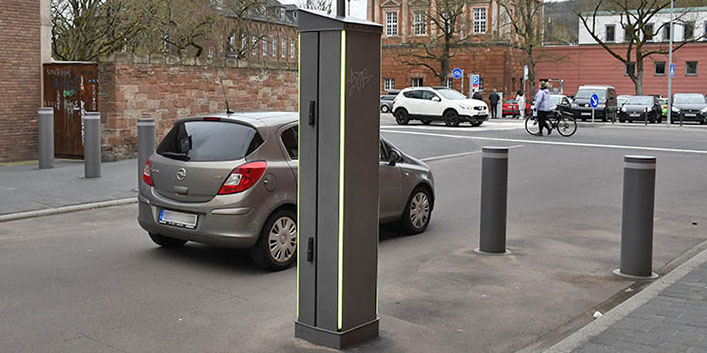
Die neue Fußgängerzone

- LEISTUNGEN A-Z
Stadtrat stimmt zu: Land übernimmt 266 Millionen Euro Trierer Schulden
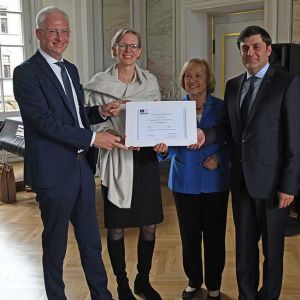
Unesco würdigt grenzüberschreitendes Erbe aus der Zeit Karls des Großen
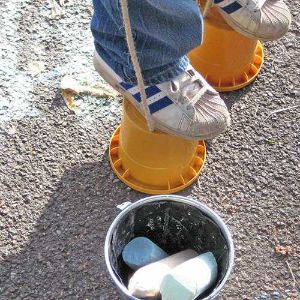
Temporäre Spielstraßen immer beliebter
Pressemitteilungen, kulturschaufenster: einfallsreichtum und kreativität gefragt.
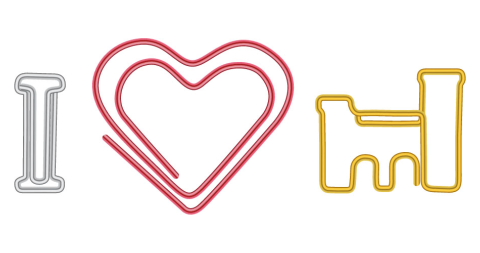
Wir suchen Sie!
Willkommen bei der stadtverwaltung trier.
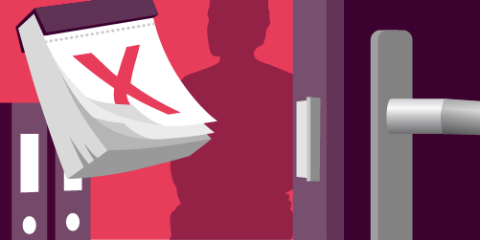
Termine und Öffnungszeiten
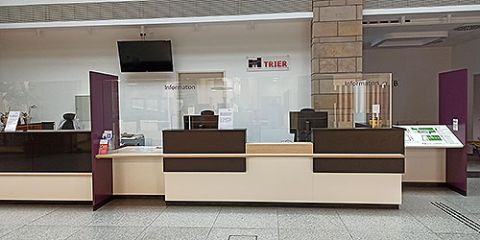
Pass- und Meldewesen
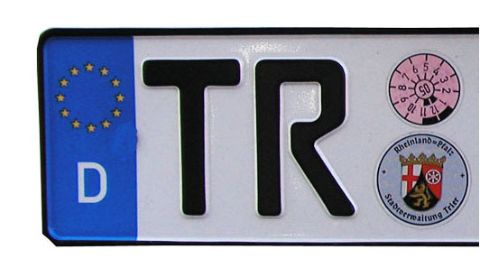
KfZ-Zulassung
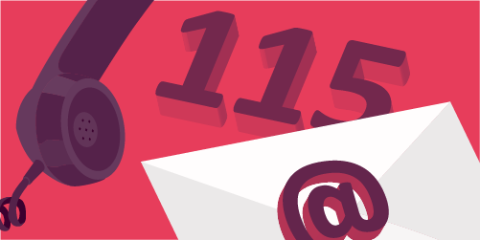
Kontakt zur Stadtverwaltung

Klimaschutz

Volkshochschule Trier
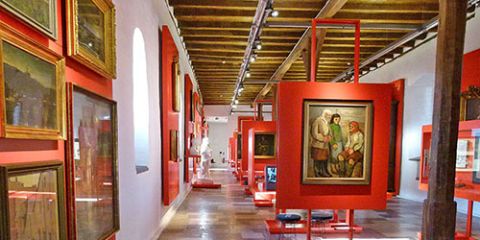
Stadtmuseum Simeonstift
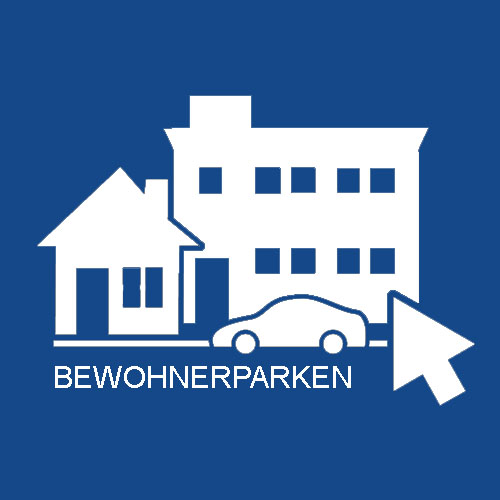
Rathaus Zeitung
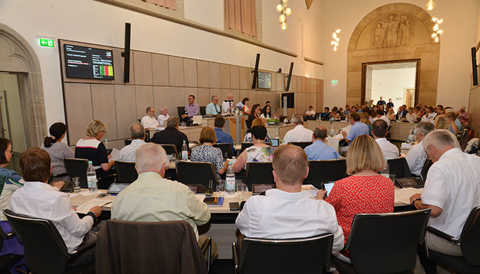
Bürgerbeteiligung

Politische Beiräte
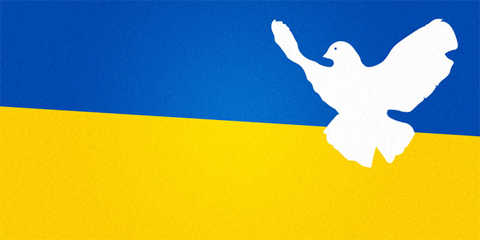
Informationen für Geflüchtete aus der Ukraine
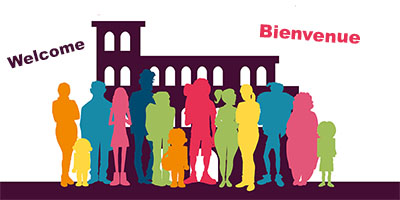
Integration in Trier

- Datenschutz
Öffentliche Führungen
Führungsübersicht, rundfahrten, erlebnisführungen / theater, kostümführungen, weinführungen, themenführungen, weitere anbieter, individuell unterwegs - apps.
- Französisch
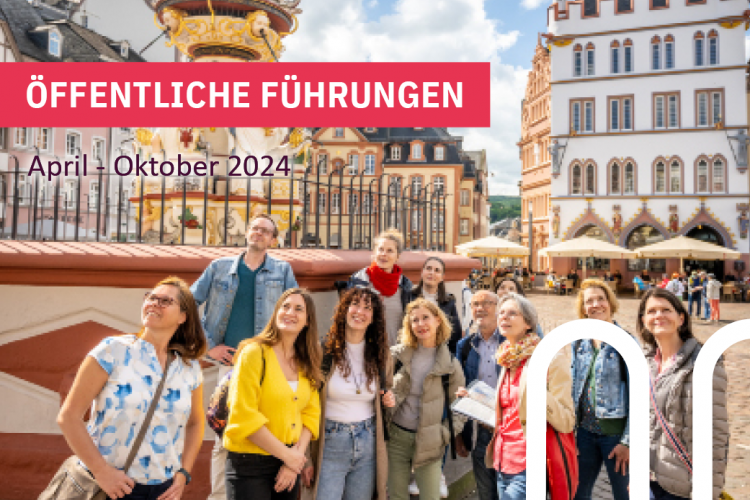
Führungen April - Oktober
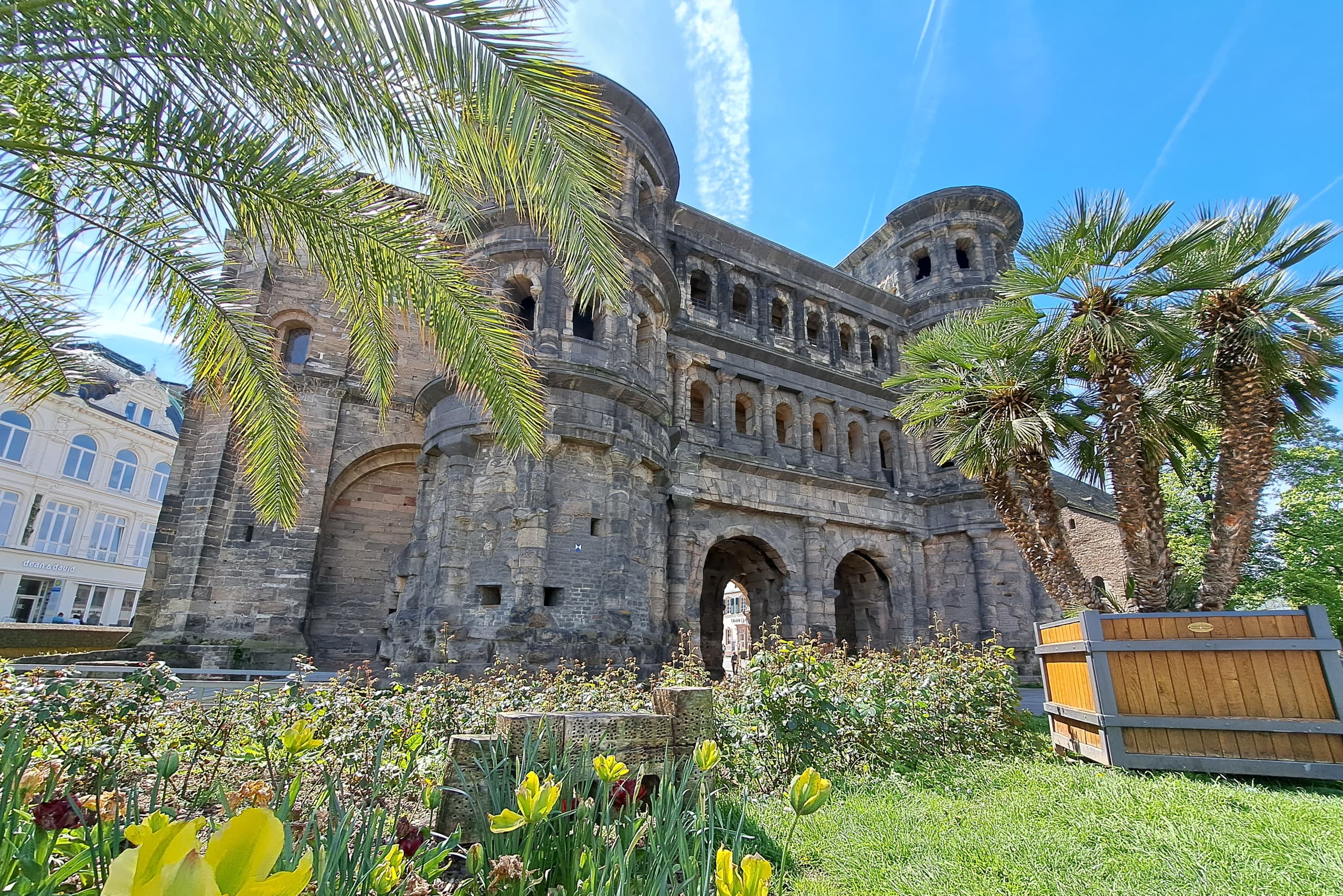
Stadtrundgang 1 - Von der Porta Nigra bis zum Kurfürstlichen Palais
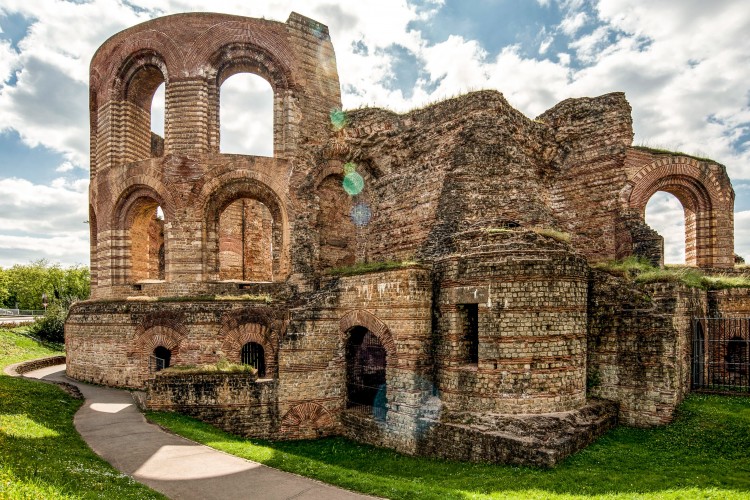
Stadtrundgang 2 – Von den Kaiserthermen bis zur Römerbrücke
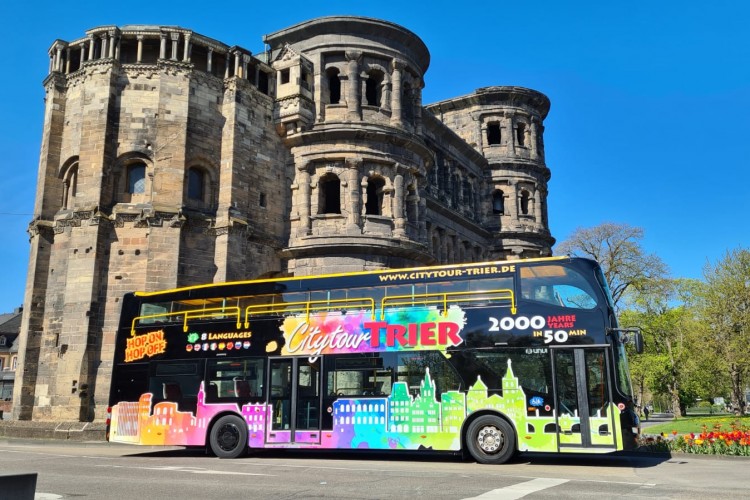
Stadtrundfahrt mit dem Doppeldeckerbus

Wein-Genuss-Tour mit dem Doppeldecker
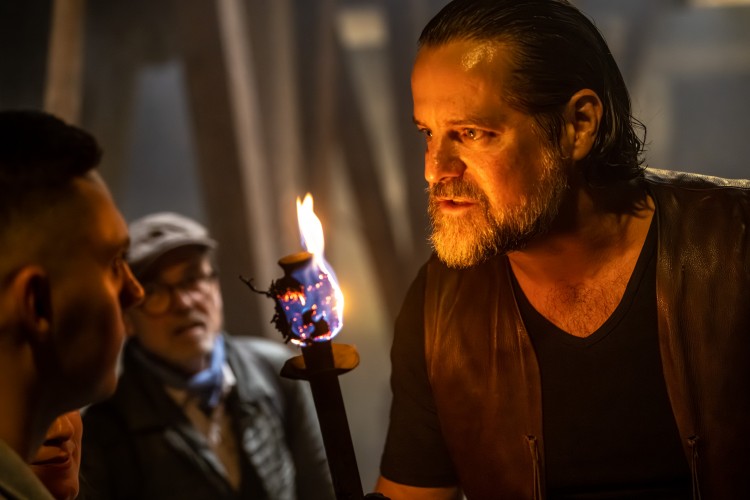
Der Gladiator Valerius
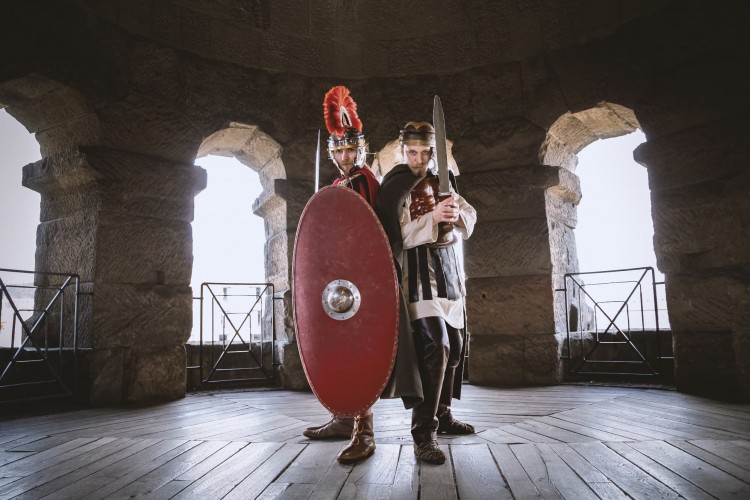
Das Geheimnis der Porta Nigra
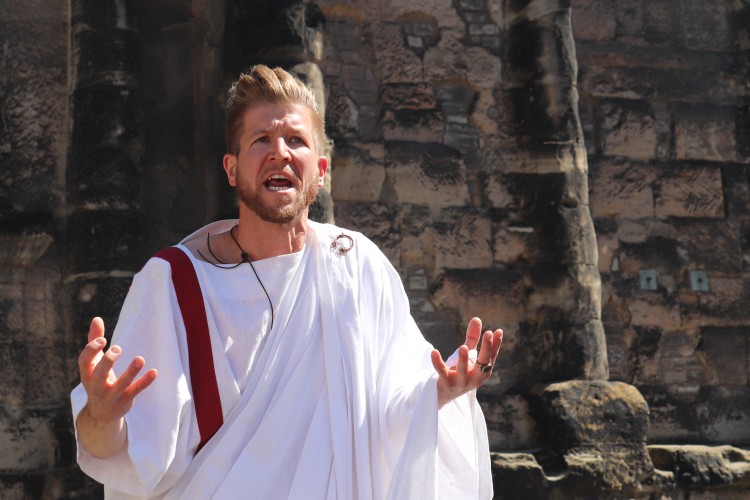
Togaführung
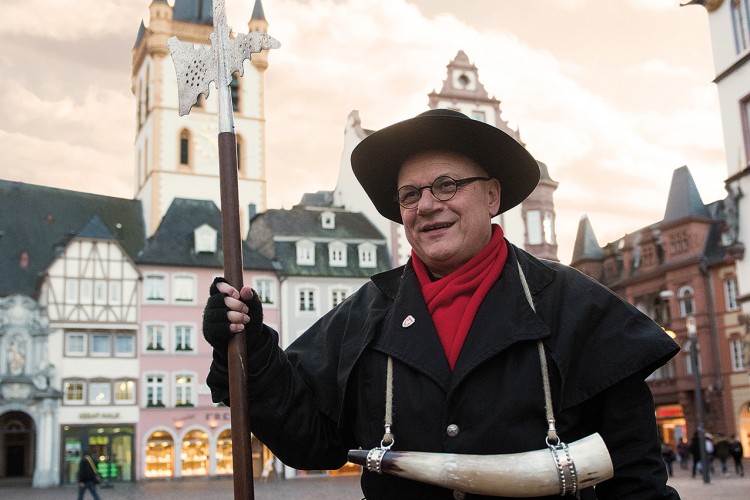
Rundgang mit dem Trierer Nachtwächter
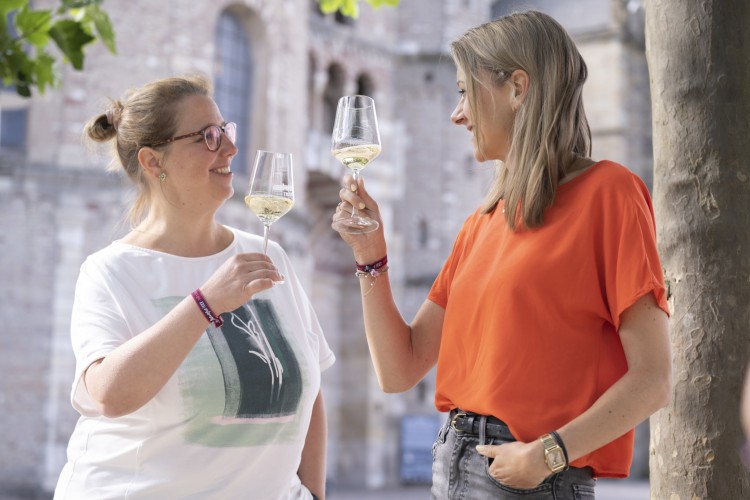
Moselwein trifft Geschichte. Wein-Rundgang
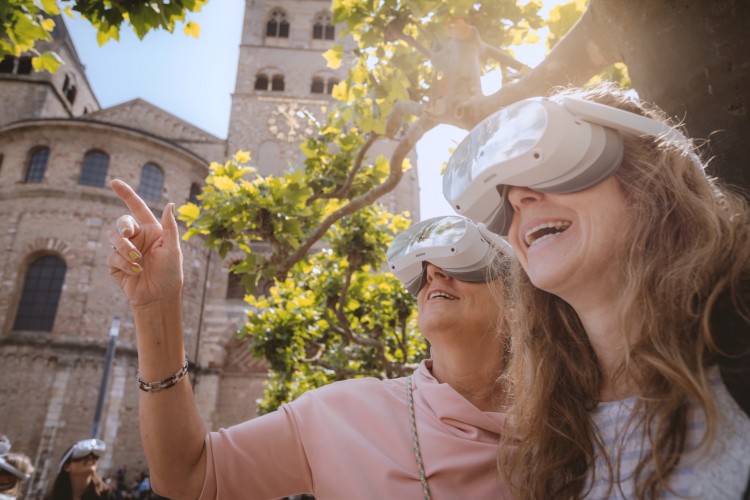
Treverer Code - VR-Stadtrundgang Trier
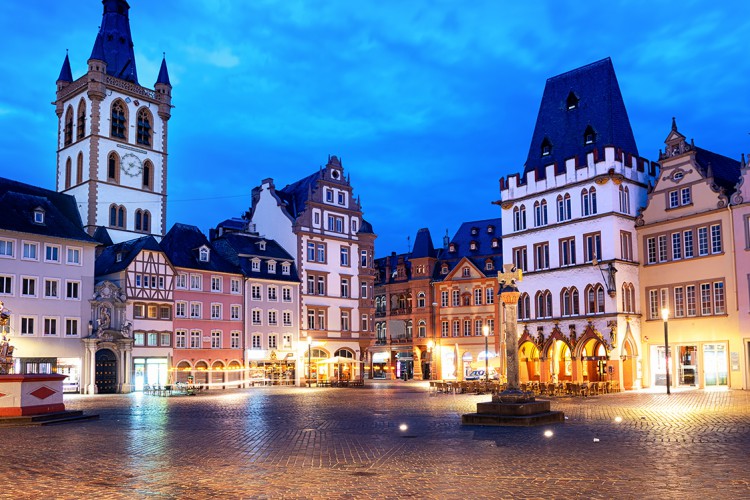
Rundgang abendliches Trier
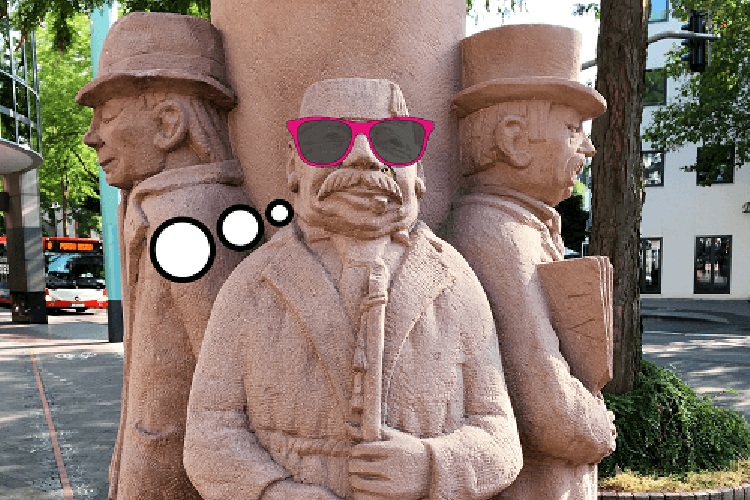
City Quest Trier
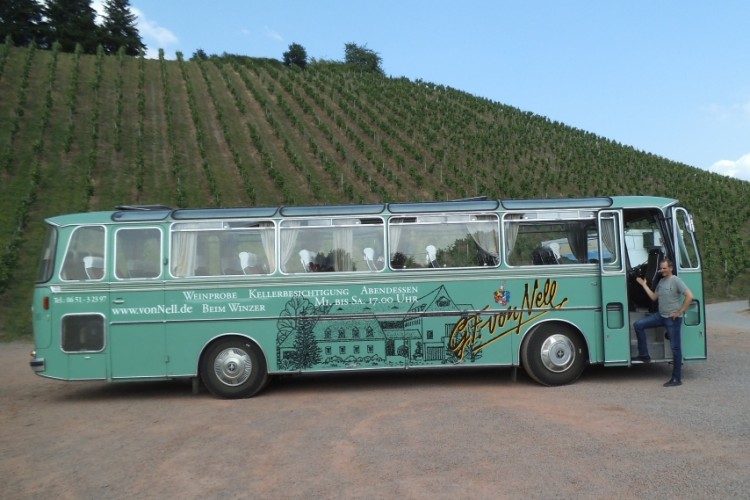
Weintour im historischen Bus
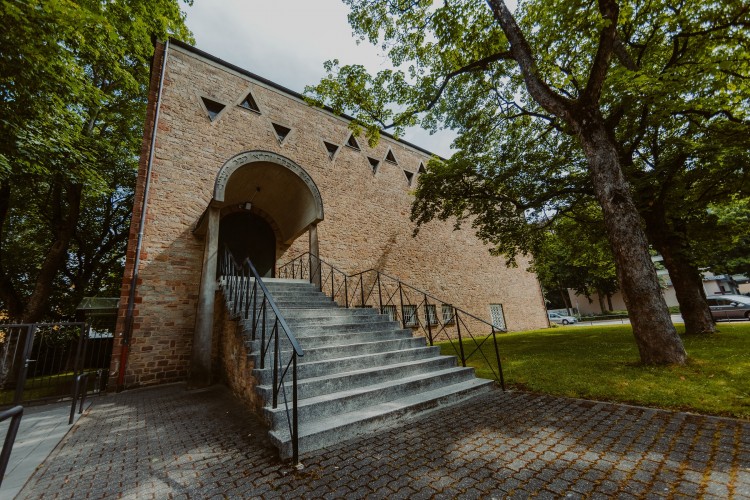
Jüdisches Leben Trier - App
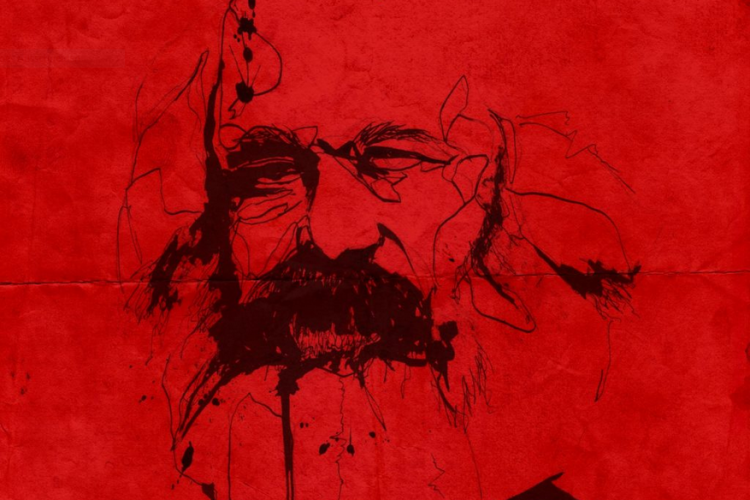

IMAGES
VIDEO
COMMENTS
Herzlich willkommen in Trier, der ältesten Stadt Deutschlands. Hier erhalten Sie Informationen rund um Sehenswürdigkeiten, Aktivitäten, Events und vielem mehr. ... Trier Tourismus und Marketing GmbH Tourist-Information an der Porta Nigra Simeonstraße 60 Geschäftsstelle Sichelstraße 34-36 54290 Trier +49 (0)651 97808-0 [email protected] ...
Trier Tourismus und Marketing GmbH Tourist-Information an der Porta Nigra Simeonstraße 60 Geschäftsstelle Sichelstraße 34-36 54290 Trier +49 (0)651 97808-0 [email protected]. Quicklinks Brochures Media gallery City of Trier Your Day in Trier Centre of Antiquity QuattroPole
Trier's Tourist-Information is your first point of contact for your stay in Trier. We assist you in planning bike tours and hikes, your visit to the UNESCO
The team at Trier Tourismus und Marketing GmbH will be happy to help you plan your trip and assist you in organising your stay: We are here for you! On the map . Tourist-Information an der Porta Nigra. 54290 Trier . DE. Phone: +49 651 978080. E-mail: [email protected]. Website: www.trier-info.de.
Founded in 16 BC during the reign of Roman Emperor Augustus, Trier is Germany's oldest city and an important site for ancient art treasures and monuments, such as the Porta Nigra, the best-preserved city gate from the ancient world. Roman emperors and later bishops, electors and ordinary people have made Trier what it is today.
Address: Porta-Nigra-Platz, 54290, Trier. 2. Tour the Historic Cathedral of Trier. Cathedral of Trier. The huge High Cathedral of Saint Peter, more commonly referred to simply as the Cathedral of Trier (Trierer Dom), can trace its foundations all the way back to the 4th century, making it one of the oldest churches in Germany.
On the banks of the Moselle River, just 6 miles from the Luxembourg border and 120 miles southwest of Frankfurt, lies Trier, Germany's oldest city. Founded as a Roman colony by Emperor Augustus in 16 B.C., evidence of Roman times still lingers in the city, giving it the nickname "Rome of the North." Trier was also the birthplace of Karl Marx ...
The 4-star superior Park Plaza hotel is situated in the centre of Trier's pedestrian zone. The hotel's interior design and décor reflect the city's unique character, i.e. its ancient heritage. Even the Relaxarium wellness facilities have a Roman look and feel. So, it's a great starting point for exploring Trier's UNESCO World ...
Top Things To Do In Trier. 1. Explore Porta Nigra. Simeonstrasse and Porta Nigra Trier. Arches, aisles and bas-reliefs in the Porta Nigra. Porta Nigra Trier (Porta Nigra is latin for black gate ), is the symbol of the city, the sole surviving Roman gateway to Trier, which was built in the 2 nd century AD.
Get around [ edit] 49°45′19″N 6°38′24″E. Map of Trier. Walking is the best way to travel around the city, though a vehicle is good when visiting the stadium. Also there is a scenic overview up the hill by the stadium where you can see the entire city. The city tours take you up there.
Porta Nigra. Trier's most famous landmark will set you in awe. The Porta Nigra (black gate) was erected around 180 AD and today is the best preserved Roman city gate north of the Alps. Composed of 7.200 gigantic sandstone block, the solid structure survived centuries of repurposing and reconstruction and in its time served as the residence of ...
Some Trier History Trier's original Latin name, Augusta Treverorum, reflects its founding in 16 B.C.E. by the Roman emperor Augustus.But the area had been occupied by the Celts for many centuries before the Romans arrived. Trier was an important location for the Celto-Germanic Treveri tribe (reflected in the city's French name: Trèves), which had a shrine on a spot that is now in Trier.
Trier Tourismus und Marketing GmbH Tourist-Information an der Porta Nigra Simeonstraße 60 Geschäftsstelle Sichelstraße 34-36 54290 Trier +49 (0)651 97808-0 [email protected]. Quicklinks Brochures Media gallery City of Trier Your Day in Trier Centre of Antiquity
The Trier Dom or St. Peter's Cathedral. History of Trier. Trier is the oldest city in Germany, and therefore it's one of the most famous and important cities to put on a travel itinerary.It has been inscribed on the UNESCO World Heritage list for its rich history, and is certainly on our list of world heritage sites in Germany.. The city's history is recorded back to the Celts in the ...
Trier (/ t r ɪər / TREER, German: ⓘ; Luxembourgish: Tréier [ˈtʀəɪɐ] ⓘ), formerly and traditionally known in English as Trèves (/ t r ɛ v / TREV, French:) and Triers (see also names in other languages), is a city on the banks of the Moselle in Germany.It lies in a valley between low vine-covered hills of red sandstone in the west of the state of Rhineland-Palatinate, near the ...
1. Sightsee the Porta Nigra, Trier's Old Roman Gate. Address: Porta-Nigra-Platz, 54290 Trier, Germany. Porta Nigra is a 2nd-century fortified gate of the Roman town walls. It is one of the most notable Trier attractions that you should include in your things to see in Trier.
Visitors can climb up and see the different levels of the Porta and take in surrounding views of the city as well as the interior halls, rooms, and central atrium. The famous Porta Nigra in Trier. 2. Go shopping along Trier's Pedestrian street Simeonstraße.
Trier erleben, Trier, Germany. 17,146 likes · 177 talking about this · 52 were here. "Trier erleben" ist die offizielle Facebook-Seite der Trier Tourismus und Marketing GmbH (TTM). Trier erleben | Trier
Trier Tourismus und Marketing GmbH Tourist-Information an der Porta Nigra Simeonstraße 60 Geschäftsstelle Sichelstraße 34-36 54290 Trier +49 (0)651 97808-0 [email protected]. Quicklinks Brochures Media gallery City of Trier Your Day in Trier Centre of Antiquity
Trier Cathedral alone is enough of a reason to visit. With more than 1,700 years of history under its belt, it's the oldest in the country. The architectural mix of Gothic, Baroque and Romanesque elements attest to the cathedral's long history, but the treasury is also worth a visit. It displays a remarkable collection of religious art ...
TOURISMUS. STADTPLAN. LEISTUNGEN A-Z. AUSSCHREIBUNGEN. VERANSTALTUNGEN. BAUSTELLEN. Aktuelles Schäden durch Klimawandel: Baumfällungen auf dem Petrisberg nötig ... Stellen- und Ausbildungsportal der Stadt Trier. mehr. Themen. Willkommen bei der Stadtverwaltung Trier. Öffnungszeiten und Termine ...
Tourist-Information an der Porta Nigra Simeonstraße 60 Geschäftsstelle Sichelstraße 34-36 54290 Trier +49 (0)651 97808-0 [email protected]. Quicklinks Trier barrierefrei Prospekte Mediengalerie Stadt Trier Dein Trier Zentrum der Antike QuattroPole MOSEL - Faszination Urlaub Romantic Cities Historic Highlights of Germany UNESCO ...